Piolets d'Or Announces the "Significant Ascents" of 2023
This list of 68 climbs is effectively a "long list" used to select nominees of the prestigious alpine award.
Hiking 100 miles in 9 days on Spain’s Camino de Santiago pilgrimage route with my wife and our baby girl helped me to reflect on what it means to trust the path I'm on in life.

There is a place that people from all over the world go to in search of the answers to life’s questions. Whether suffering a loss, hoping to find direction, or stuck at a crossroads in life, thousands of people every year take part in an ancient tradition to walk to the Santiago de Compostela cathedral where legend has it, St. James's remains were interred after he was martyred by beheading in 44 AD. For centuries, pilgrims have walked on the dozen or so trails that follow earlier Roman trade routes leading towards the Atlantic coast of Galicia and ending at Cape Finisterre, Spain's westernmost point. I walked the last 100 mile stretch of this pilgrimage path with my 7-month old baby on my back to answer my own question: Now that I have a daughter, are my greatest adventures in the past, or are they still to come? But the answer wasn’t waiting for me inside the cathedral, the answer was the journey itself.
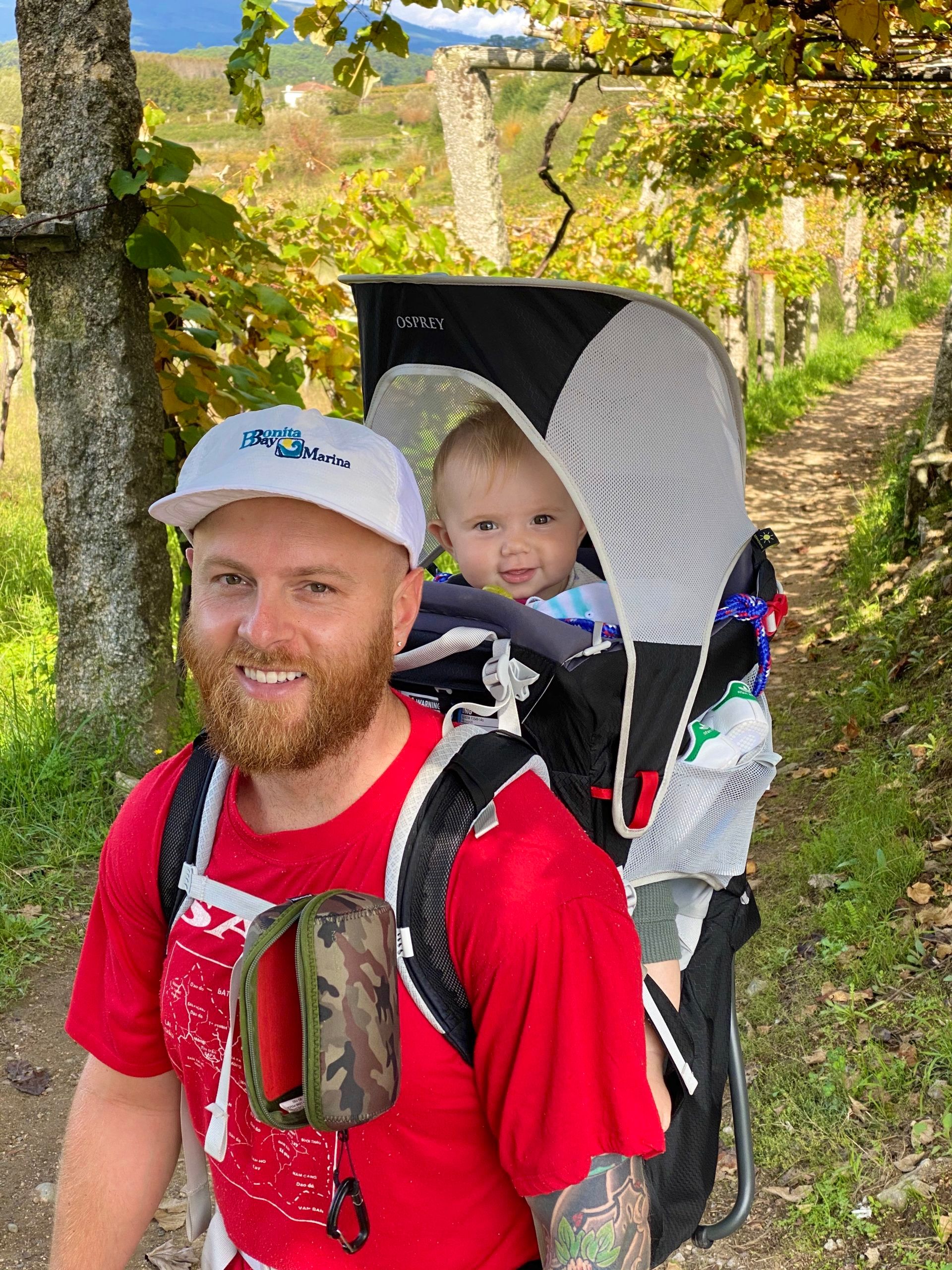
In my wedding vows, I included a promise to my wife, Erin, that I would “follow her to the ends of the Earth,” because, over the past 18 years, our relationship has revolved around traveling together. We first traveled abroad together as college sweethearts and the allure of faraway places has only grown over time. We’ve been living in Europe as US expats for five years now, and we’ve made the conscious decision to sacrifice invaluable time with friends and family in pursuit of making unforgettable travel memories.
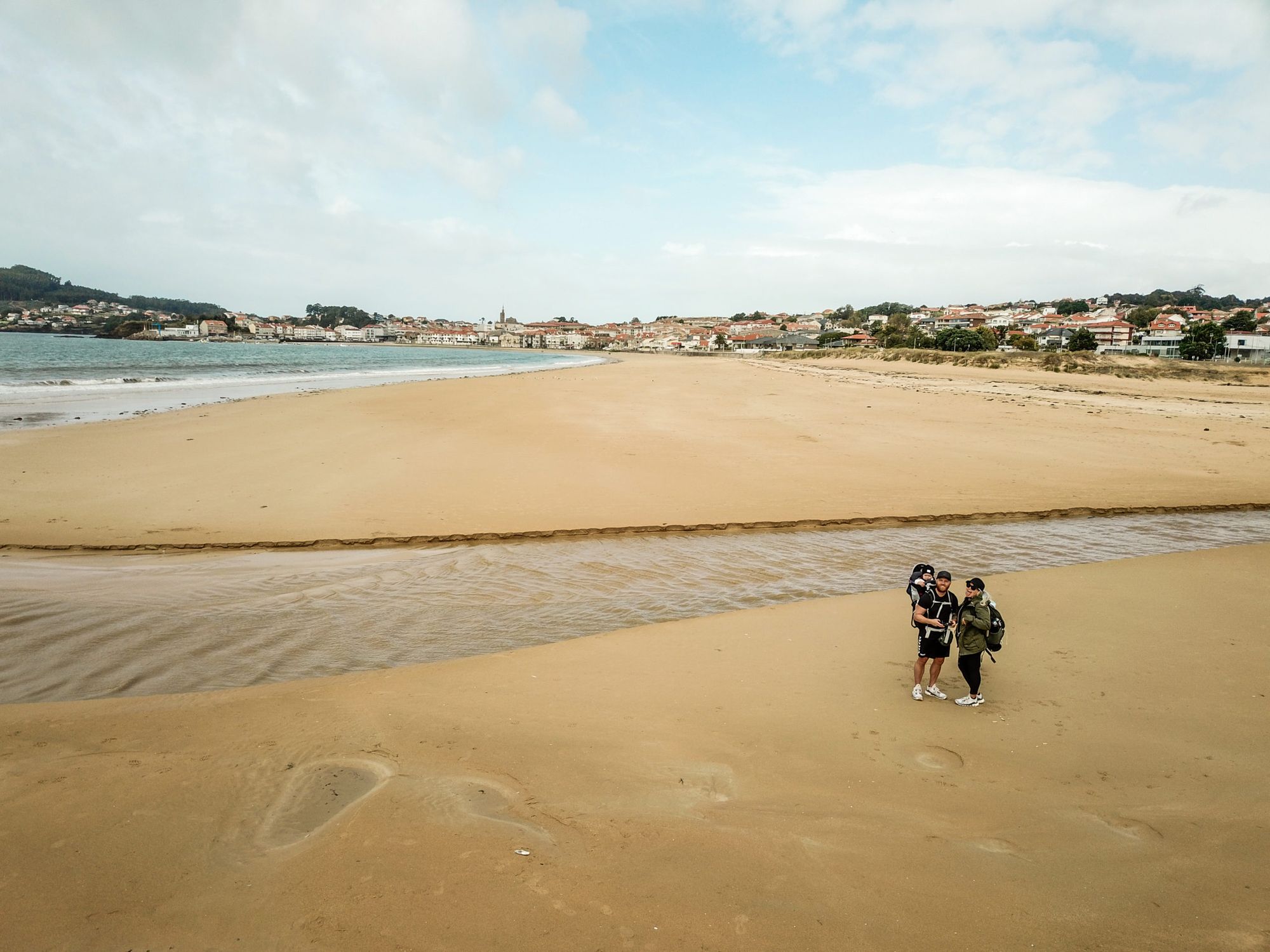
But, when our daughter Vahla was born this year, we worried that our vagabond lifestyle of transcontinental flights and off-road scooter riding would come to an end. We decided to commit ourselves to a challenge that would let us know if our days of freedom were truly behind us. I’ll be forthright in admitting that caring for a baby while living in a foreign country has been way harder than I ever imagined, especially without any family support, but perhaps hitting the road would simplify things. With the pandemic still an active threat, we researched local, slow-travel getaway options. [Find your own remote hiking trip on OutdoorVoyage.com]
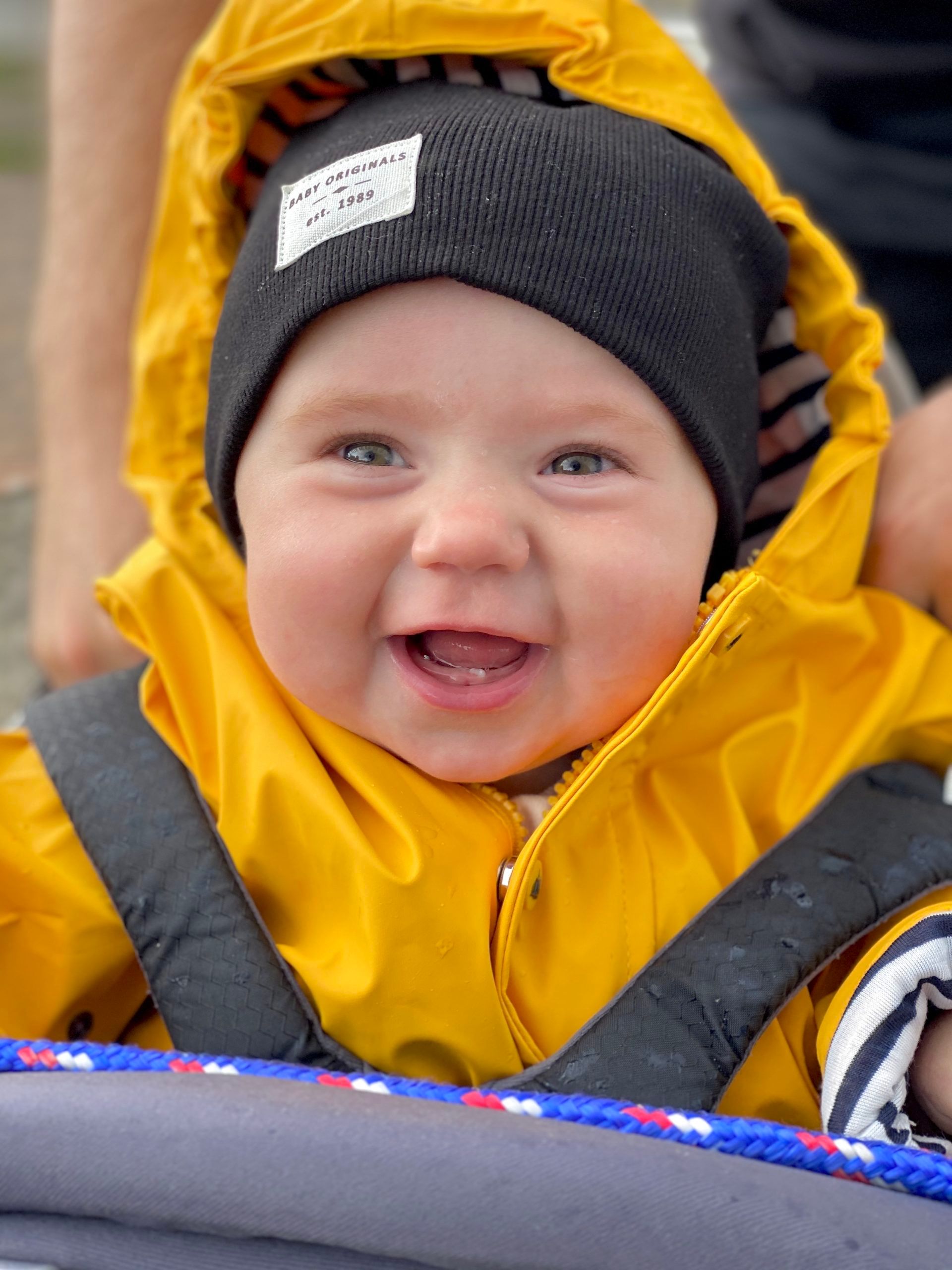
We had heard of the Camino de Santiago here and there from co-workers, a pilgrimage trek dating back to medieval times, but we knew that it takes four to six weeks, and surely we couldn’t attempt to walk 500 miles with a baby on zero training. But we were drawn to the idea of a family expedition, one that required logistical planning, gear preparations, and a leap of faith. So we committed to walking the last 100 miles (160 km) of the Camino de Santiago starting just north of Spain’s border with Portugal and ending at the Santiago de Compostela Cathedral. No planes, no boats, no taxis or rick-shaws, just wake up and walk. [Watch a video of our journey here].
https://www.youtube.com/watch?v=eb7Rv0OTvfI
As our trip drew nearer, Erin and I both harbored concerns, although they differed in both intensity and priority. I was most nervous about the 10-hour drive across Spain and Portugal to the starting point, given that Vahla does not appreciate being strapped into the car seat for long stretches. Also, what if the weight of the baby carrier becomes too much for my back? What if Vahla can’t adjust to sleeping in a new, strange place every night? Shouldn’t we have trained to walk over 10 miles every day with no breaks? What if we get caught out in a storm? But, to paraphrase Paolo Coelho’s The Pilgrimage, we could think about the hundreds of ways we could fail, but we had already taken the first step.
Our journey begins on my 37th birthday with a cross-country drive from Spain’s Costa del Sol in the South through its Extremadura region, which is Spain’s version of The Outback - 16,000 square miles of rugged terrain that is home to a wildlife reserve. We cross the border to Portugal and drive north towards Porto, where I catch my first glimpse of the Atlantic ocean through a shroud of nebulous mist. Compared to the Med, the Atlantic looks cold and dangerous. The looming sky above us and the forecast for our Camino look foreboding with rain showers, so we make a quick stop to purchase more protective rain layers and hope that we don’t have a week of walking through miserable rain ahead of us.
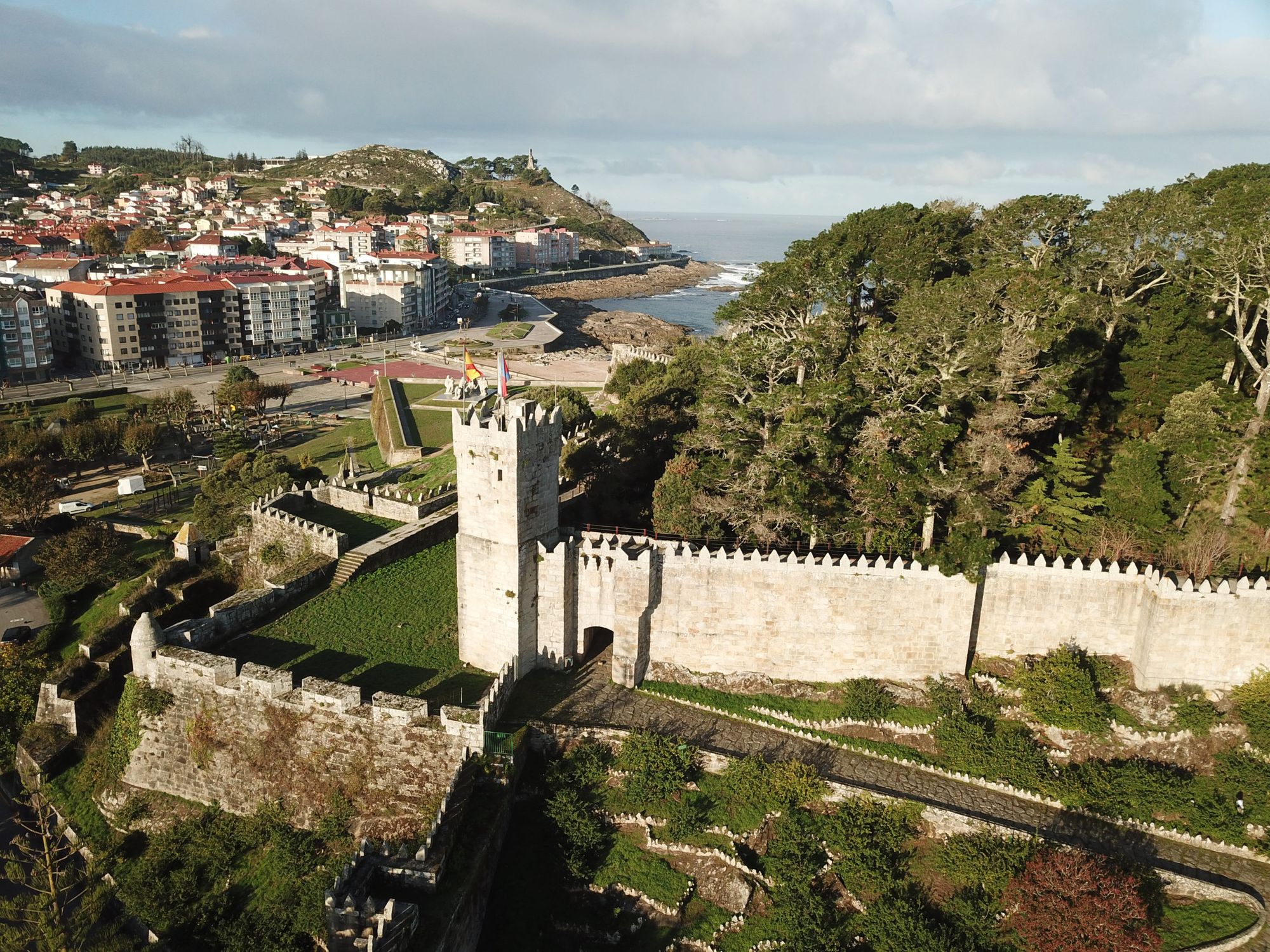
“I think we’re staying in that castle!”
After 10 hours of driving, we exit Portugal and cross back into Spain to reach our starting point of Baiona, a fishing town with a splendid marina and a medieval historical center. We drive through the gate of a walled fortress with a tower that was once used as a dungeon. “I think we’re staying in that castle!” Erin blurts out from the back seat. The walls of our Parador are adorned with paintings of old naval battles and I can attest that sleeping through the night even felt and sounded like being inside the hold of an old wooden ship. Of course, it’s possible to walk the Camino in more minimalist, bare-bones fashion while staying in communal lodgings called albergues, but we like to add a few luxurious indulgences into our challenging trips, and Paradors offer an immersive historical experience.
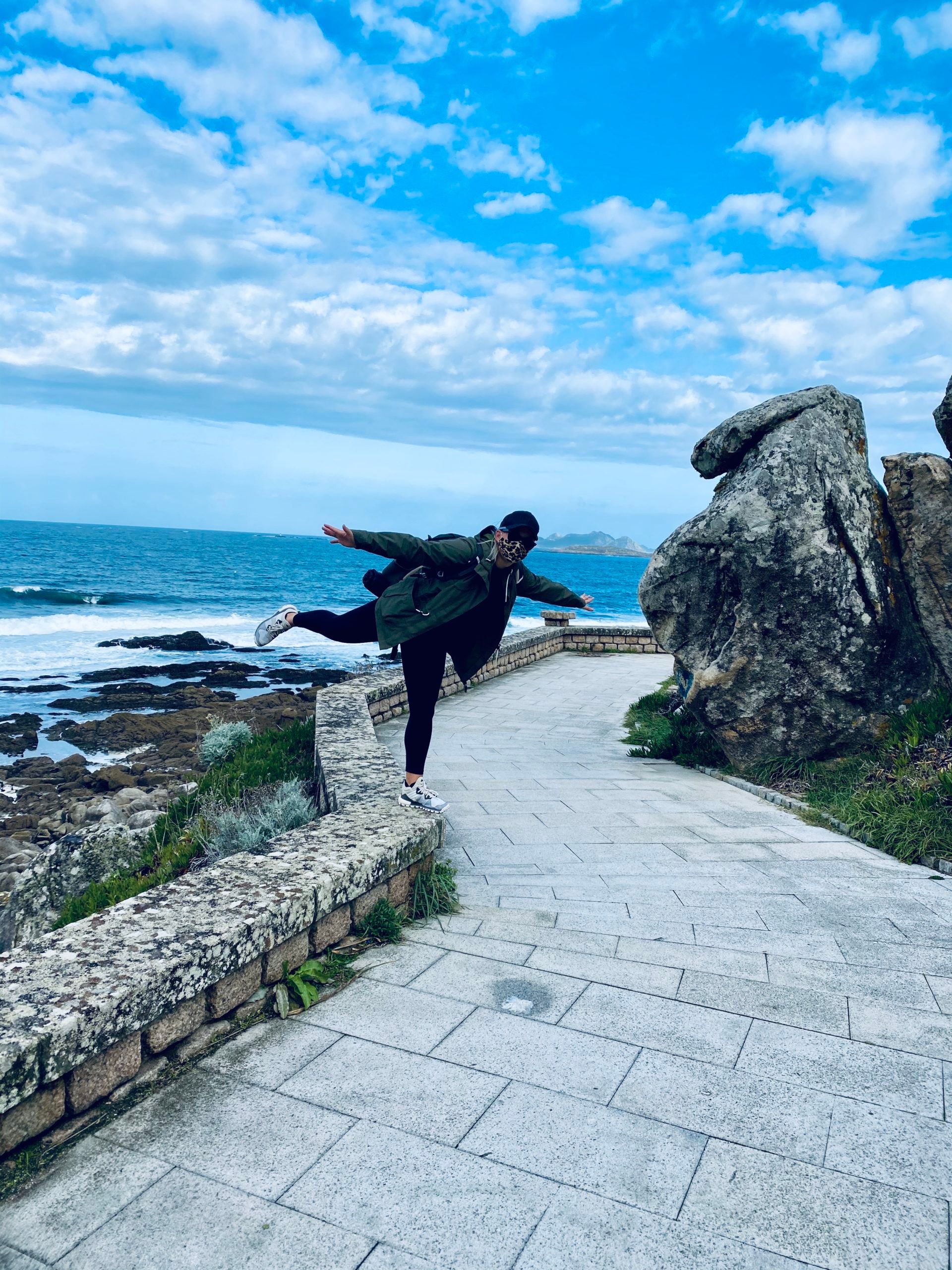
We arrive at sunset and say goodbye to our car for the next 10 days. Both Erin and I are aching to go hiking straight away along the sea until the sky goes pitch black, but instead, we put baby Vahla to bed in our room and sit down on the bathroom floor with a glass of wine for my birthday dinner - certainly no luxury. We sit in silence as if we’re in the horror movie A Quiet Place, but it’s hard to squelch our excitement for tomorrow.
On the morning of Day One, we instantly disregard our plan. Although we intended to ease into our journey with Vahla by starting out with a four-mile walk to the next town, we couldn't resist exploring the perimeter of the Monterreal peninsula due to its scattering of towers, gates, batteries, and bastions perched just above the sea. So, before we even reach the Camino trail, we’re already three miles in the hole, but this is exactly why we chose the Portuguese Coastal Way.
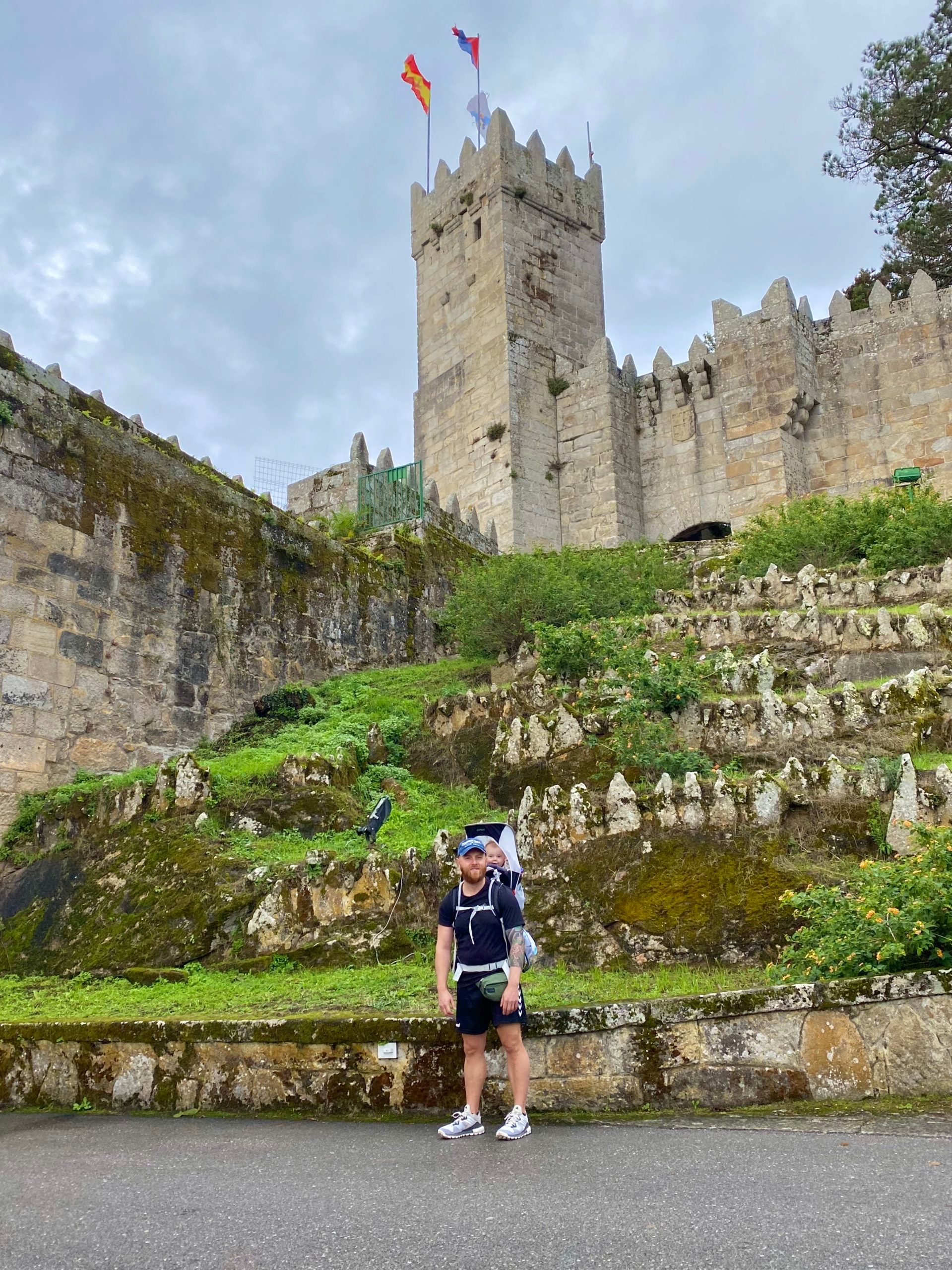
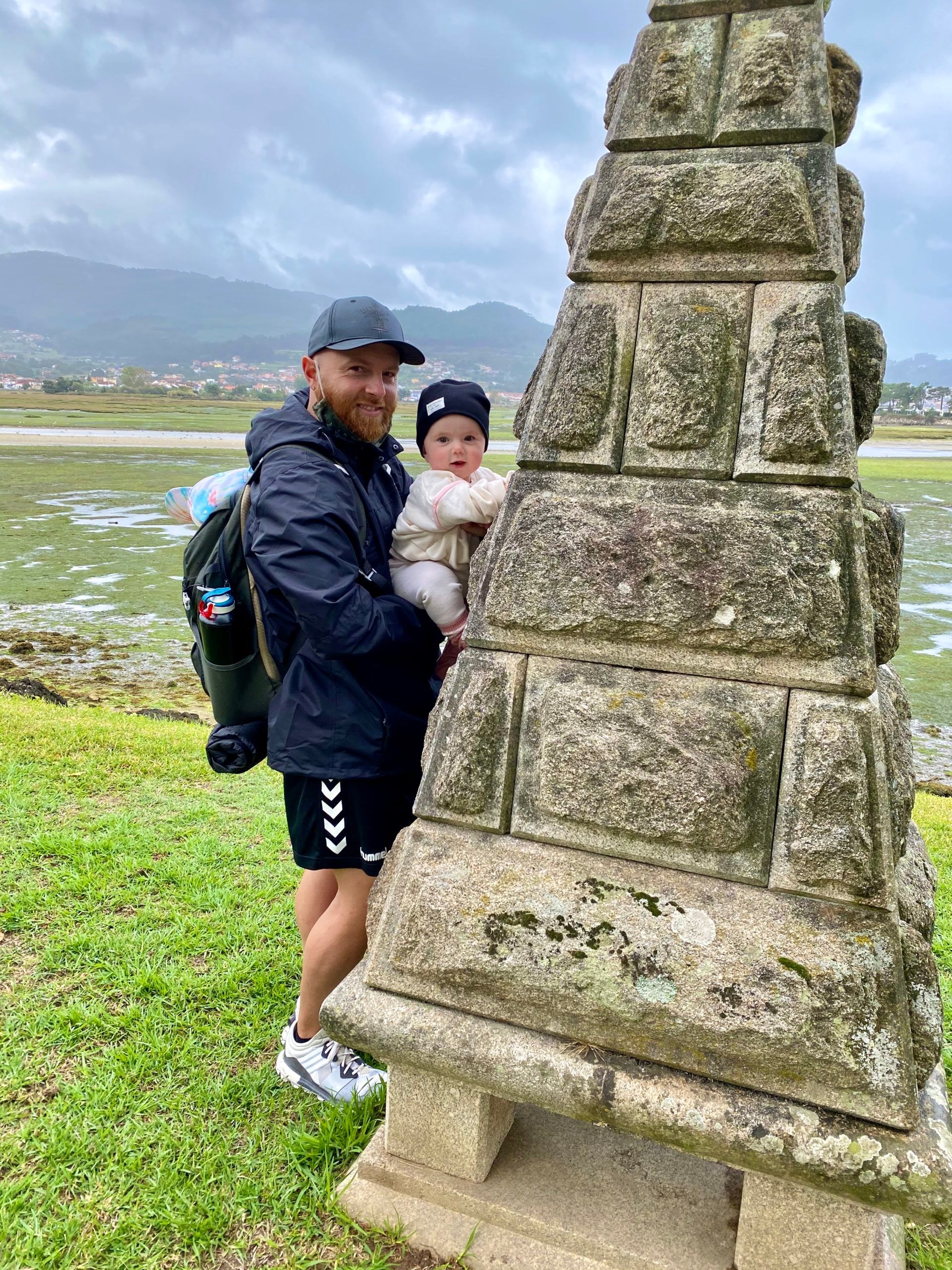
That’s when one of my biggest fears for the trip comes true - a sudden downpour. We pause to let Vahla observe some of the other children on a playground when, without warning, the sky starts pelting heavy rain down on us. I hustle into the nearest shelter which happens to be the smallest chapel I’ve ever seen. It’s dark and drafty with a few rows of empty pews. The religious pilgrimage aspect of the Camino is already playing out. The tradition encourages you to visit many churches on your way to Santiago, and in order to receive your Compostela certificate at the end, you must keep track of them with stamps, like a spiritual scavenger hunt.
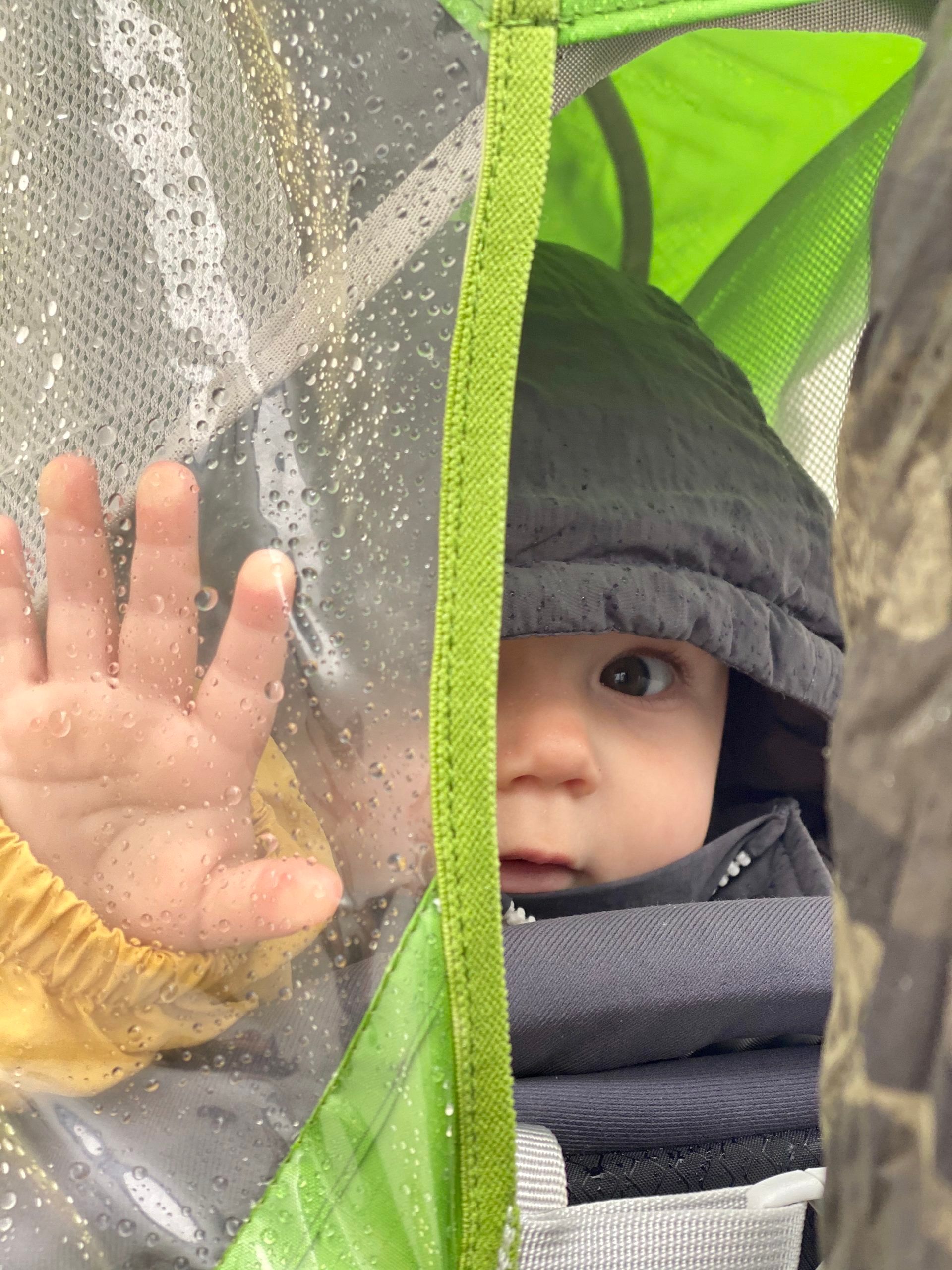
After the rain lets up, I discover one of my favorite aspects of the Camino - feeling entitled to a feast. When you put in double-digit mileage before lunchtime, you feel the right to scarf. Would you like to taste our local white wine before noon? Fill-er up! How about a croissant with chocolate filling AND chocolate sprinkles? Don’t mind if I do. We stop for an alfresco tapas lunch of fried calamari in a lemon-butter sauce with local Galician white wine. I could get used to this.
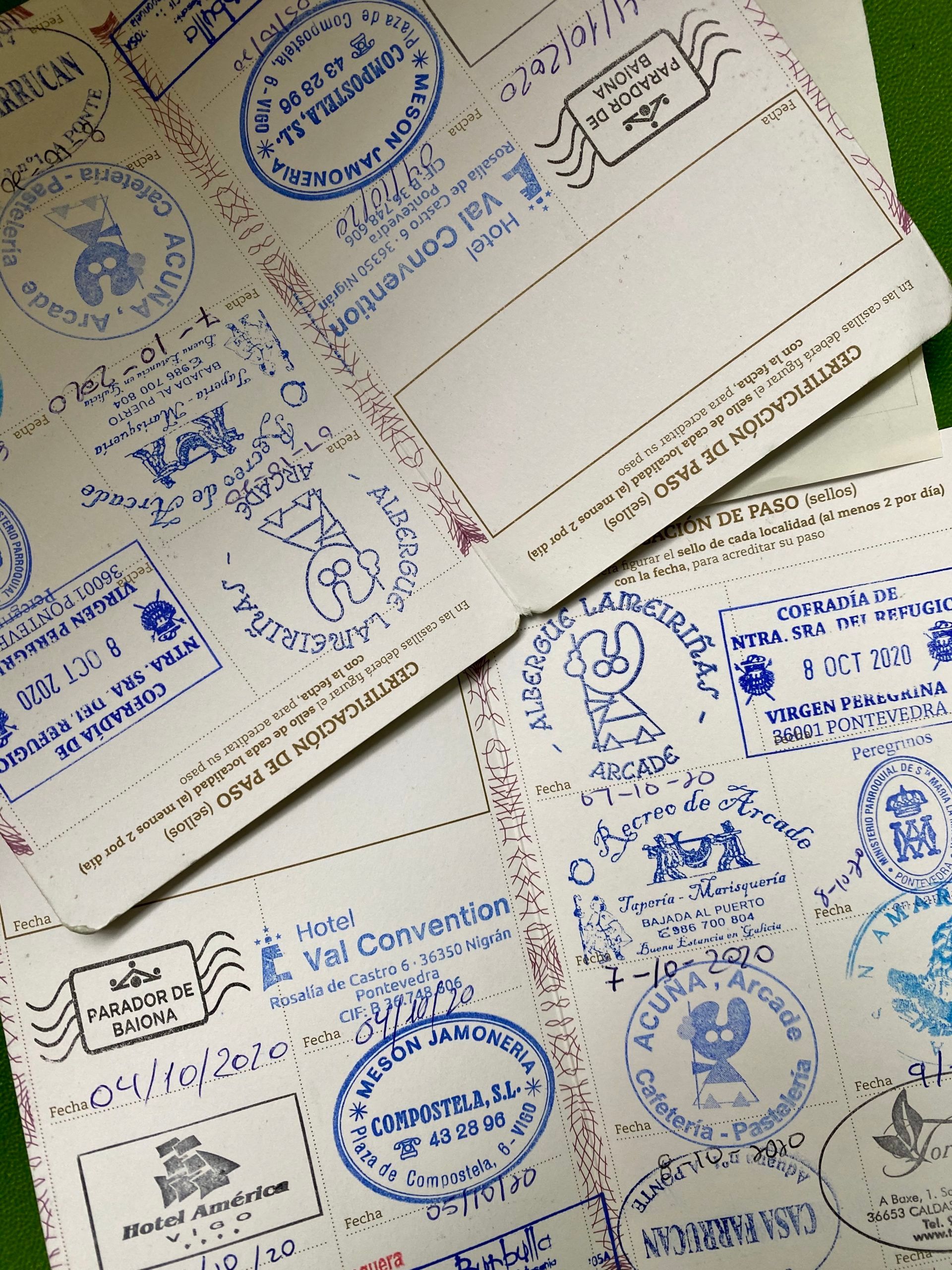
I continue on into the afternoon a bit tipsy but it’s no matter because there is no need to concentrate on navigation on the Camino. All you have to do is follow the spray-painted yellow signs and mile markers to know that you’re on the right path. “It would be nice if life were like that,” I think to myself. We pass by local elders every so often and they wish us “Buen Camino!” Each time this happens, it feels like we are a part of something bigger than us.
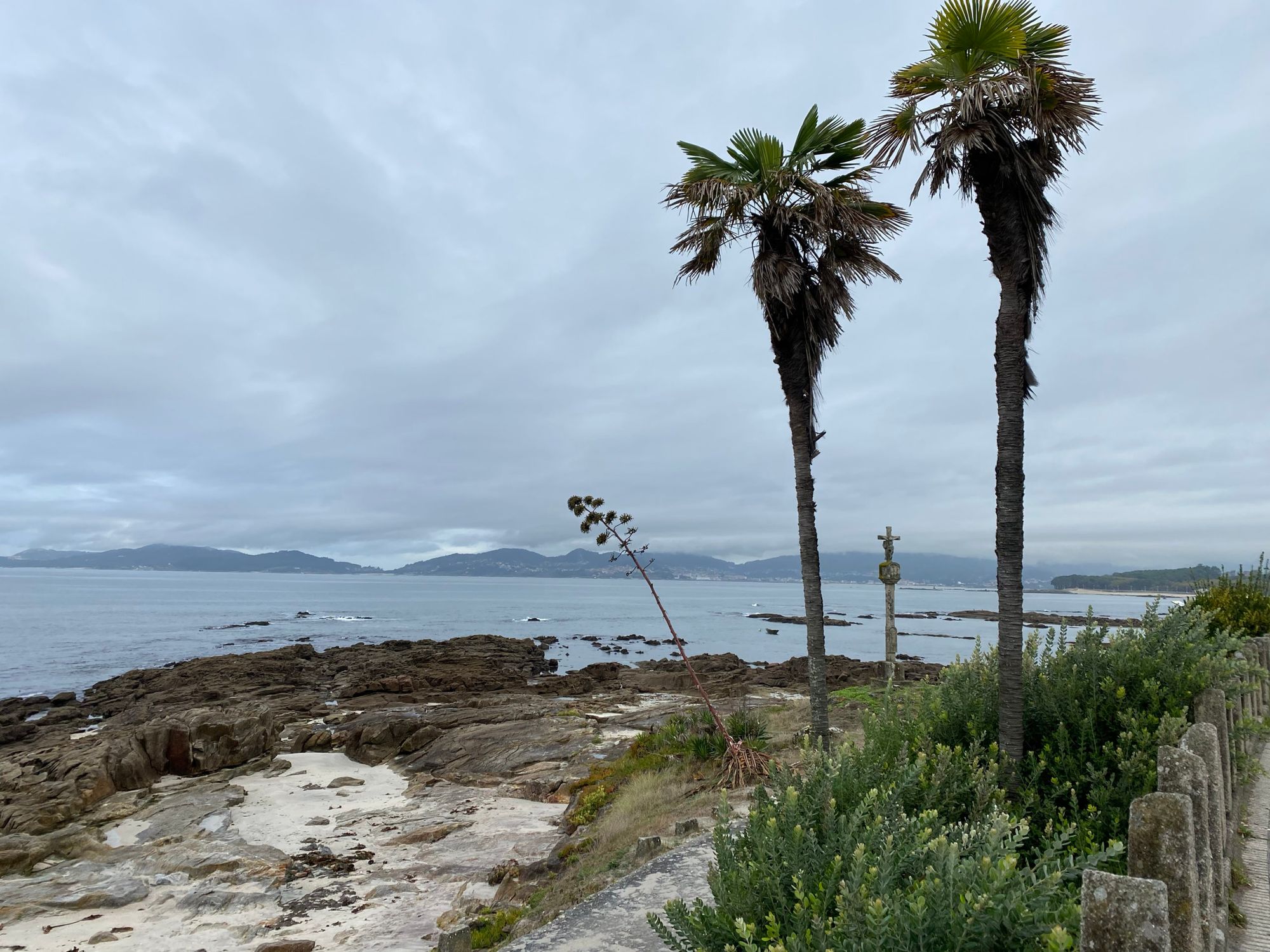
We reach our hotel in Nigran to signify the end of Day One and I plop Vahla down on the bed. Could this be? She already seems older. Although she might not remember this journey in her mind’s eye, I hope that she will see it as a constellation as she connects the dots in the story of her life. Perhaps this trip will give her confidence when she considers chasing a big dream like climbing Everest as an adult because she’ll know that she’s been doing these challenges since she was a baby.
Through the misty-wet rain, we can still make out the tower of our Parador jutting above the sea. We hike through a constant drizzle this morning under dark, low-lying clouds. With 12 miles until our next destination, we know we have to keep our pace up. As we march forward, the tower slips away into the mist until it is no longer in sight. From afar, pixelated surfers dot the hazy shoreline like an impressionist painting.

We make a quick stop for provisions at a local fruit shop and the Abuela owner tickles Vahla’s feet while she digs her first tooth in a white peach. I notice a prominent graffiti tag on the nearest overpass, “Galiza is not Spain.” It represents an independence movement, similar to nearby Basque-country sentiments, of patriotism in the region’s language and culture. After living in Andalucia, Spain for 8 months now, I have to agree. Galicia’s geographical home in the northwest of the country and its proximity to the Atlantic gives it a uniquely disparate microclimate from the south and east, which border the Med. The muted green colors of the terrain and the constant wetness in the air remind me of some of my other favorite places to travel in South Asia like Ubud, Bali, and Kandy, Sri Lanka. The residential architecture makes walking down a street feel like a fashion show, with each house attempting to outshine the next. I’m particularly drawn to the Japanese-inspired designs, which I don’t have to look hard to find.
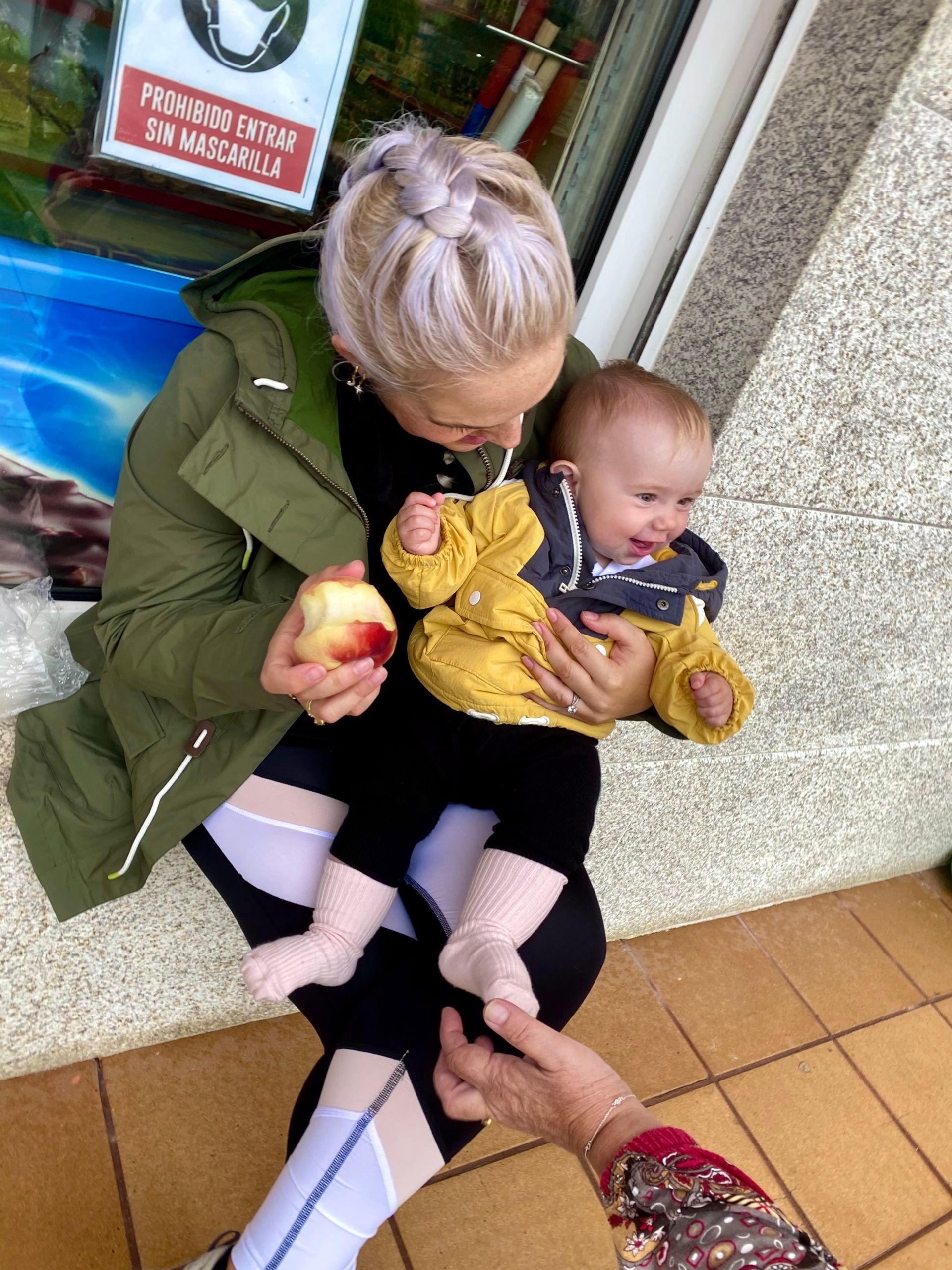
We’re still concerned with keeping up our pace but we can no longer deny Vahla a break, so we take a quick loop through a grocery store and lay out a picnic on the beach to give Vahla some sand time. After a few minutes, we rush to pack up because we don’t like the look of a menacing oncoming cloud. I’m grateful that those couple sips of white wine keep my back pain-free for the next hour.
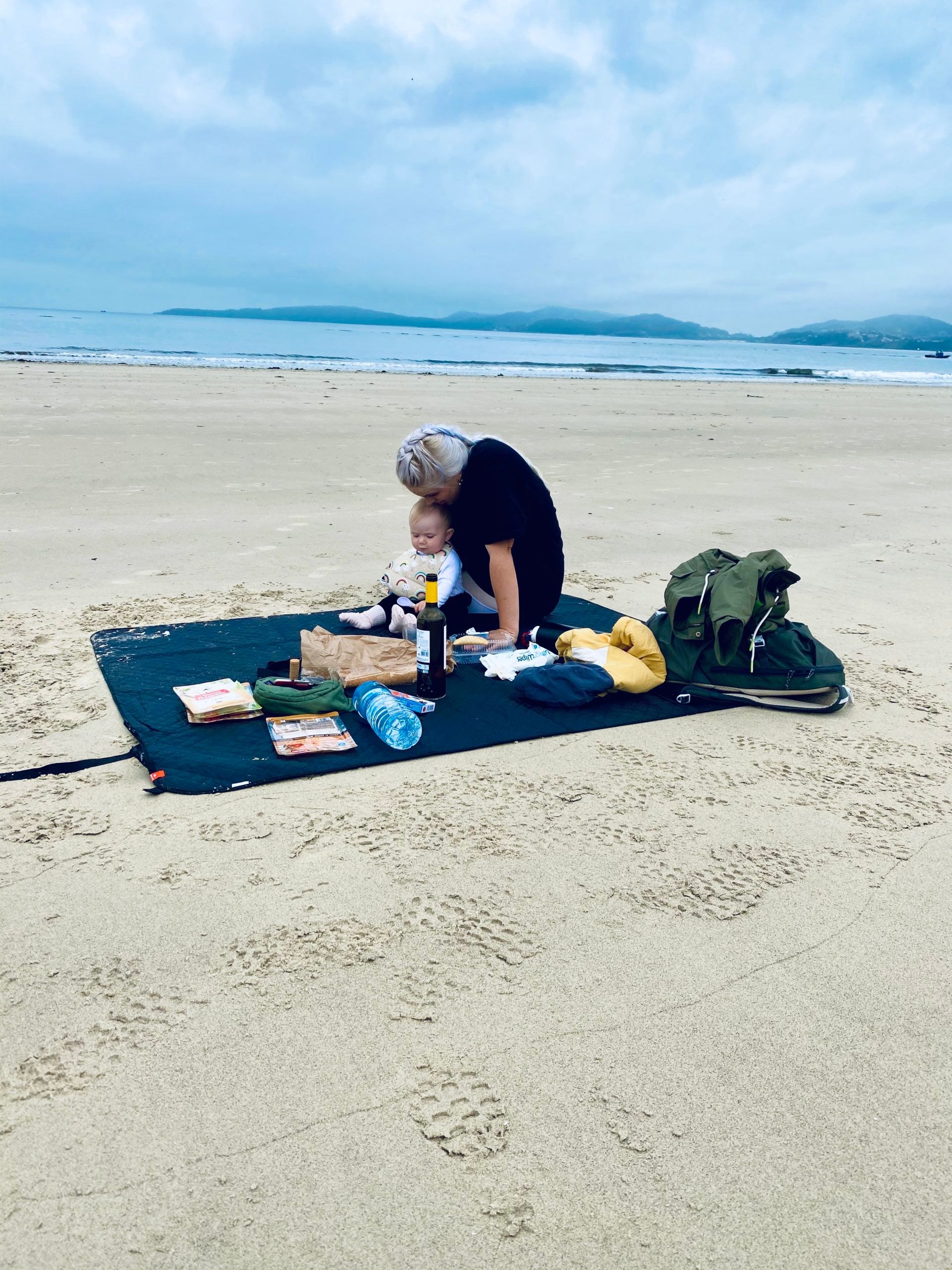
Disclaimer: The Portuguese Coastal Way includes several sections of road with narrow shoulders that many pedestrians might consider too dangerous to walk. The last 90 minutes of today’s route along an industrial shipping lane is probably the least enjoyable of the entire trip. I can feel a layer of car pollution caking on my skin and I’m wondering whether I would ever put my baby in this situation if I wasn’t on the Camino.
The day starts out with a slow, uphill climb to escape the hustle and bustle of Vigo city proper which was built over both a hill-fort and a Roman settlement. After a mile and a half, Erin hits me with a gut punch. We’ve still got a while before we reach the start of the trail. Deflated, I pause to collect myself while Erin makes a quick tour of the morning fish market. While I slouch near the entrance with Vahla attached to my back, an old man approaches. I tell him that I don’t speak Spanish well, and I can only pick out every third or fourth word, but I can tell that he’s giving me important instructions. He mimes that I need to straighten my back more and invert the slouch in my posture. (Looking back, without this advice, I don’t know if I would have been able to complete the 100-mile journey).
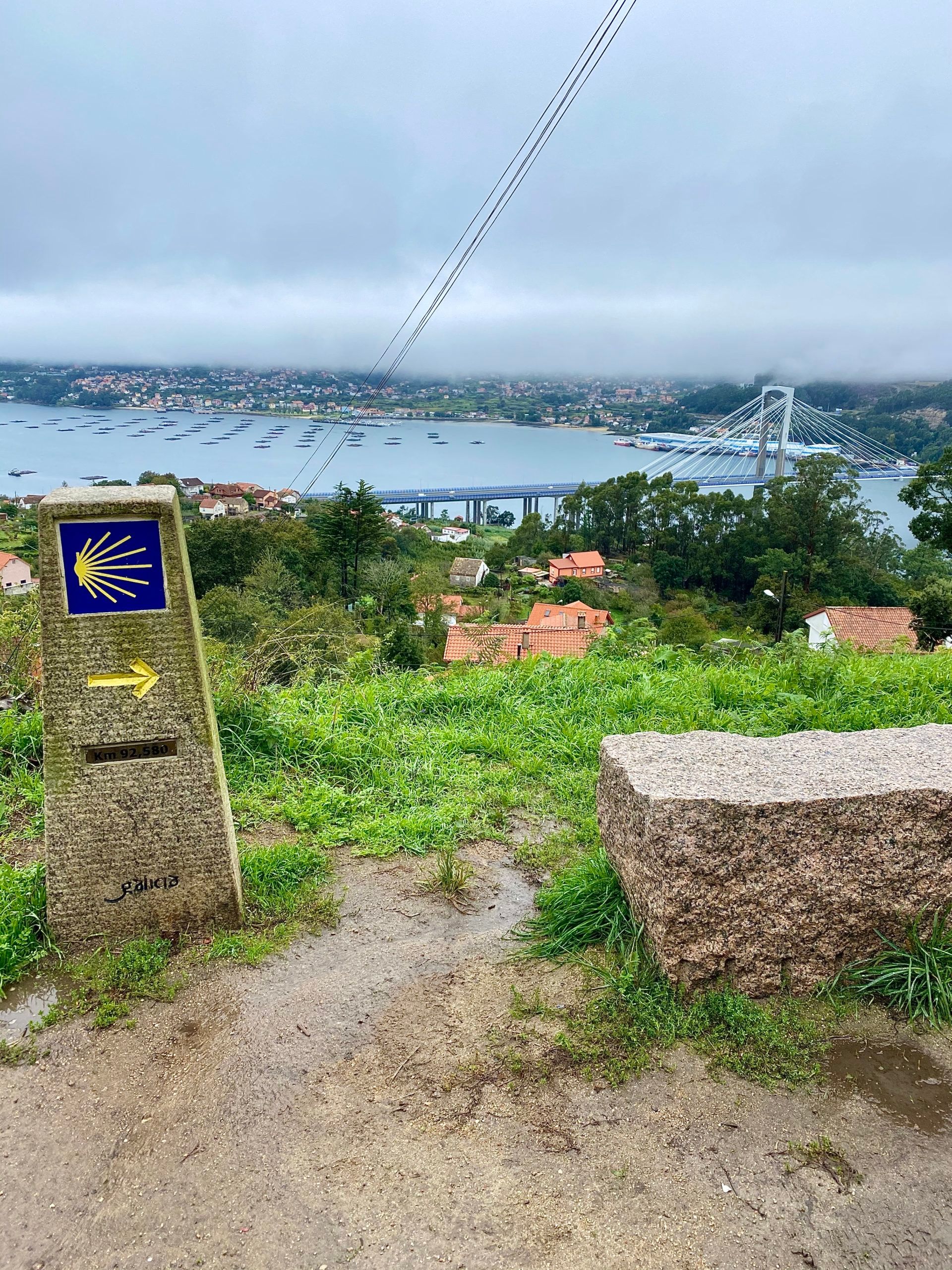
Before we continue, I take a second to double-check our navigation with Erin. By the looks of it, once we’re out of the city, there are no restaurants, tapas bars, or cafes for about 10 miles. “Now promise me that we’ll stock up on food and water before we hit the nature trail,” I ask her. However, in our excitement, we exit the city and plunge deep into the foggy cloud forest before we even realize that there’s no turning back. Although we had no food or snacks, this 10 mile stretch of the trail was my favorite of the entire trip. The beautiful red ferns and neon green moss kept our minds off hunger. Through the dense trees and thick clouds, we can just make out a scattering of country houses cascading to the water. Piles of pried open fruit lay abandoned along the border of our path. I keep my eyes peeled for monkeys.
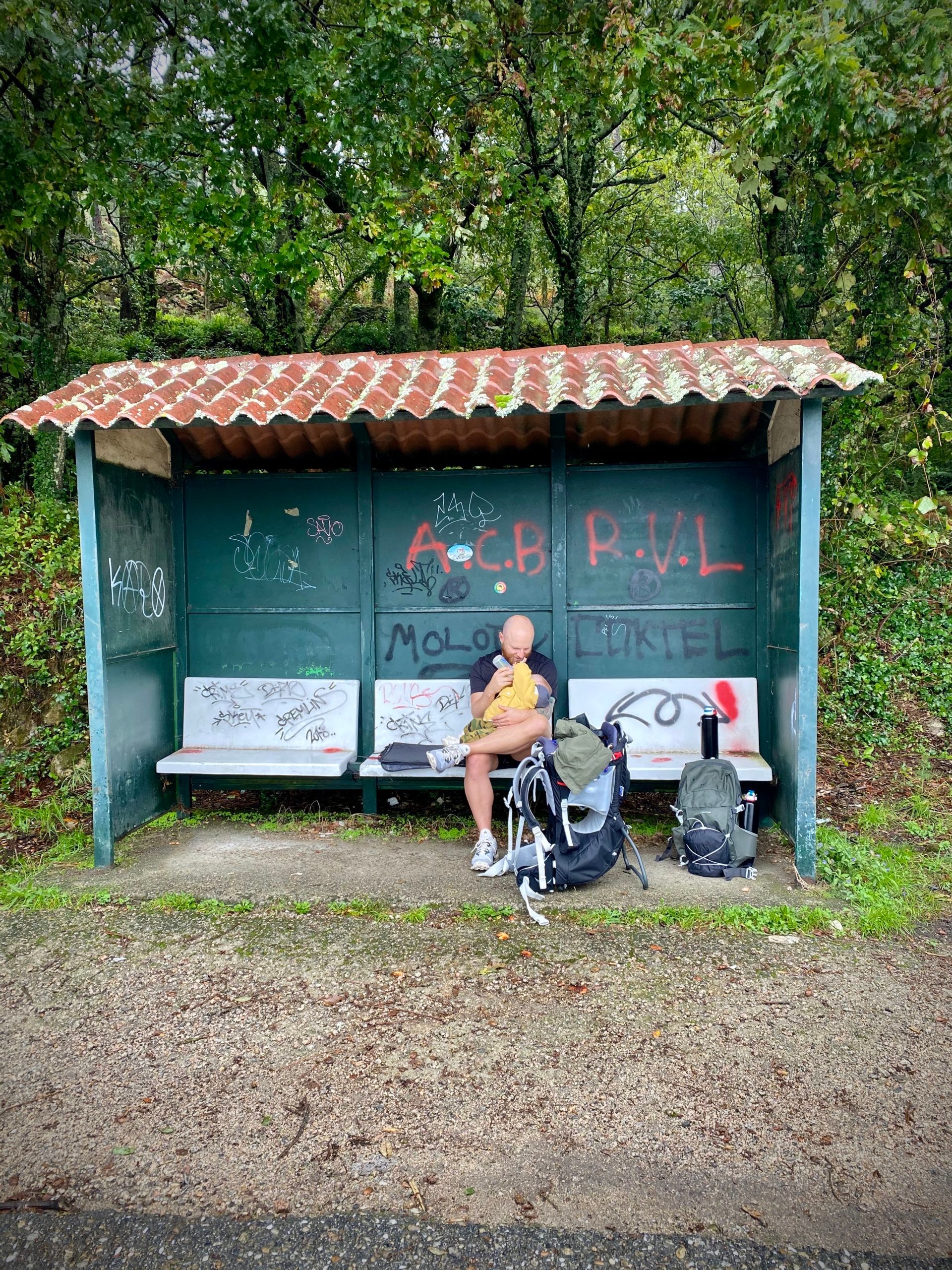
We pass by two other pilgrims who are cloaked head to toe in rain gear, poking the ground with their Nordic walking poles. For a second, I doubt my choice of shorts and t-shirt, but then I think about minimalist, alpine hiker Peter Van Geit, whose Himalayan journeys I’ve covered for the magazine, and I’m reassured that a little cold air won’t kill me.
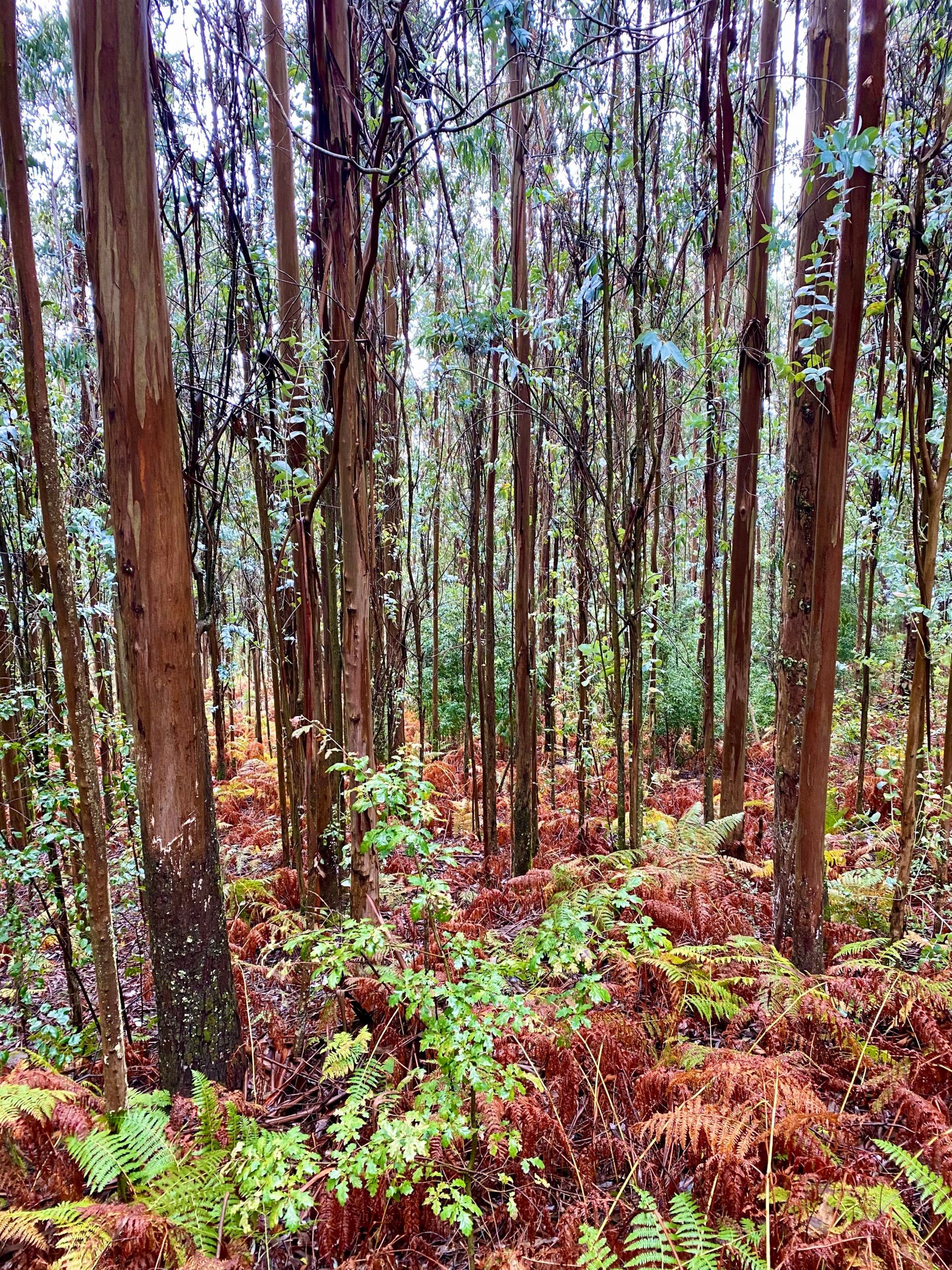
We follow the golden path painted on the ground and doze off as we walk, letting thoughts and memories flood through our consciousness. I promise myself that the next time I’m sitting in traffic, I will relive this experience in my mind.
Walking in between civilization feels far out. For the first time on our journey, we are miles away from the nearest town. The official Camino markers indicate that we still have 93 kilometers until we reach our final destination, and the end feels far away and uncertain.
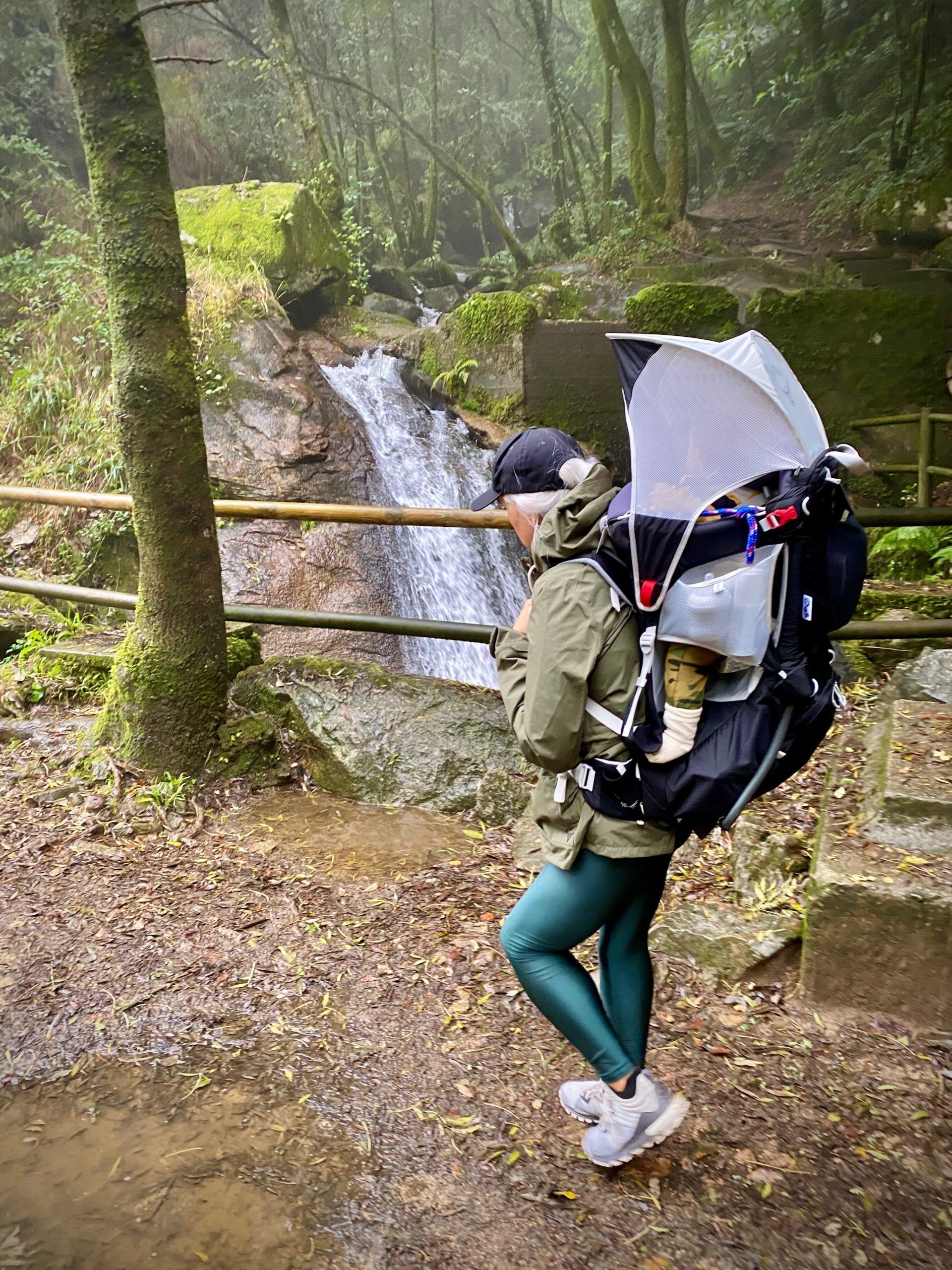
We treat this shorter 7-mile route from Redondela to Arcade as a recovery day by giving Vahla some extra rest and playtime in the morning while I try to loosen up my body with practices that I’ve learned through interviewing movement experts at The Outdoor Journal. To reduce stiffness in my back, I perform a series of spinal waves straight from the morning routine of Nick Brewer, handstand artist, and movement coach. Then I prep my legs and hips for another day of weighted walking with some floor mobility drills and long squats as recommended by natural lifestyle coach Tony Riddle. Finally, I apply a generous coating of CBD lotion to my lower back so I can start the day’s journey with a nice tingle rather than a molten lava burning sensation. I take a moment to appreciate setting off at a walking pace, with all of the extra details I can notice, and I trust that the places that hurt will eventually hurt less if I just keep going.
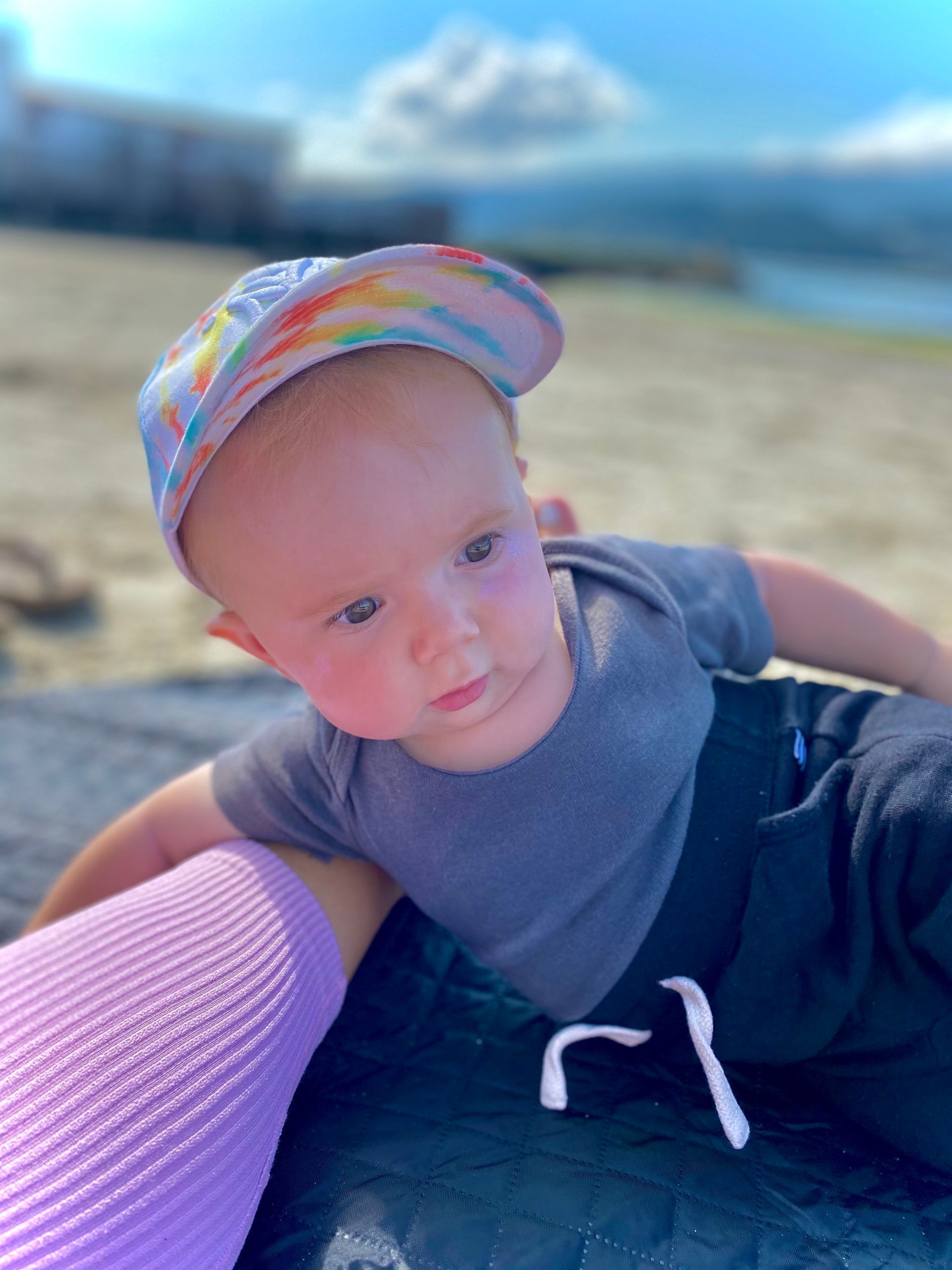
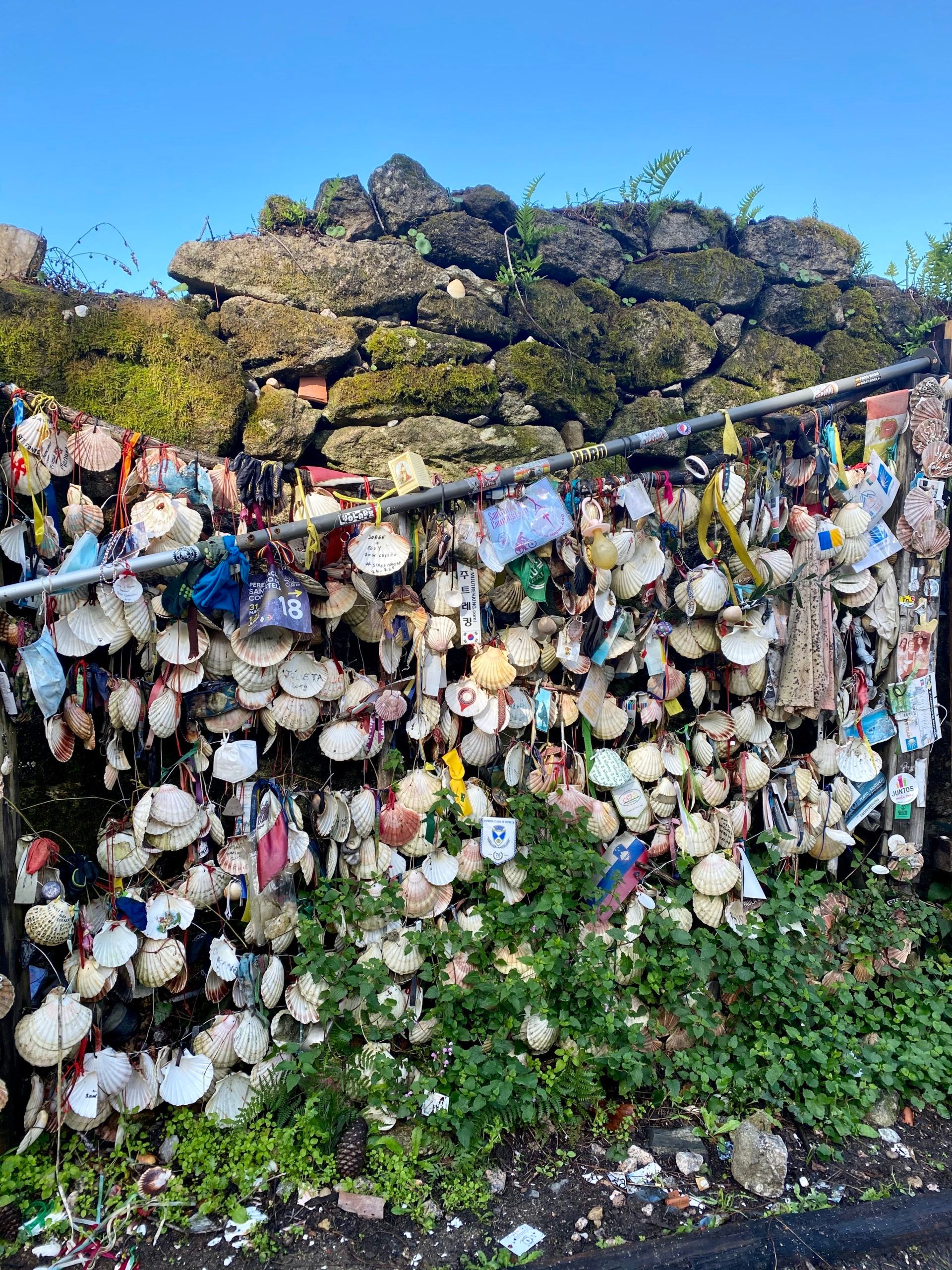
Read next on TOJ: The Untold Benefits of CBD Oil for Outdoor Athletes
Redondela is known as the “Village of the viaducts,” and it lives up to its moniker. Traversing a narrow bridge over the river seems perilous with the oncoming car and truck traffic, but its beauty makes it another highlight of the trip. I relish in the slower pace by taking out my Fuji X100F to capture the gritty texture of the stone. I’m surprised at how intimate the route is on the other side of the bridge. We wind through quaint residential streets as children wearing back-packs are leaving the house to walk to school. Each house has a garden and either a chicken coop or a workshop with wood blocks and painter rolls. Dogs and sheep are around every corner. Singing “Old MacDonald” is going to make a lot more sense to Vahla after this morning.
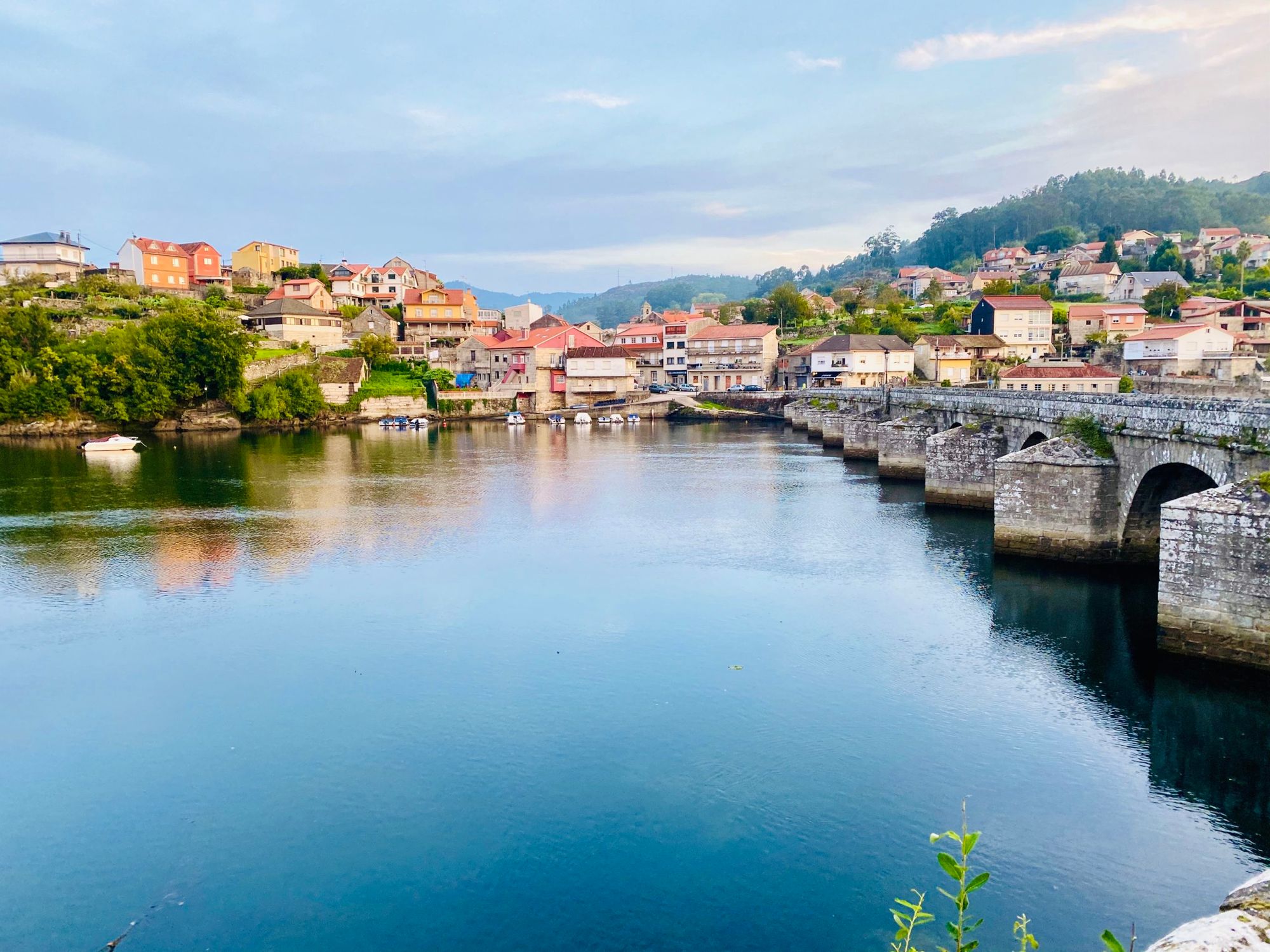
“A post-hike beer tastes better than a no-hike beer.”
Somehow we failed to learn our lesson from the day before and we skip lunch again, delaying our celebratory post-hike cervezas in lieu of a timely nap for Vahla. Finally, we sit down for our one meal of the day at a roadside restaurant that is literally set inside a roundabout. We delight in a scrumptious feast of scallops and oysters. I take note of how much better a post-hike beer tastes compared to a no-hike beer. Navigating to our hotel with a mask on and scallop breath is not as pleasant.
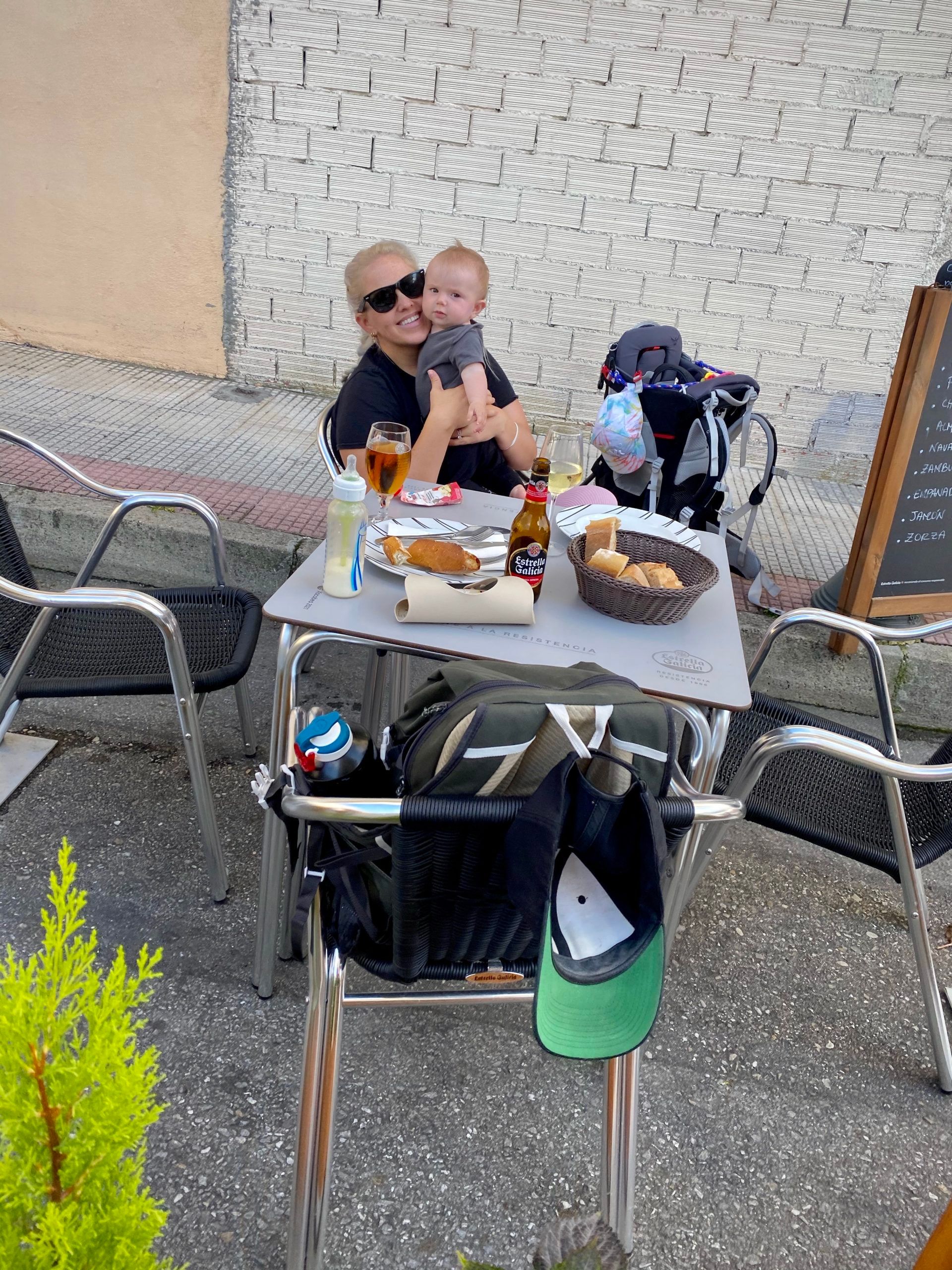
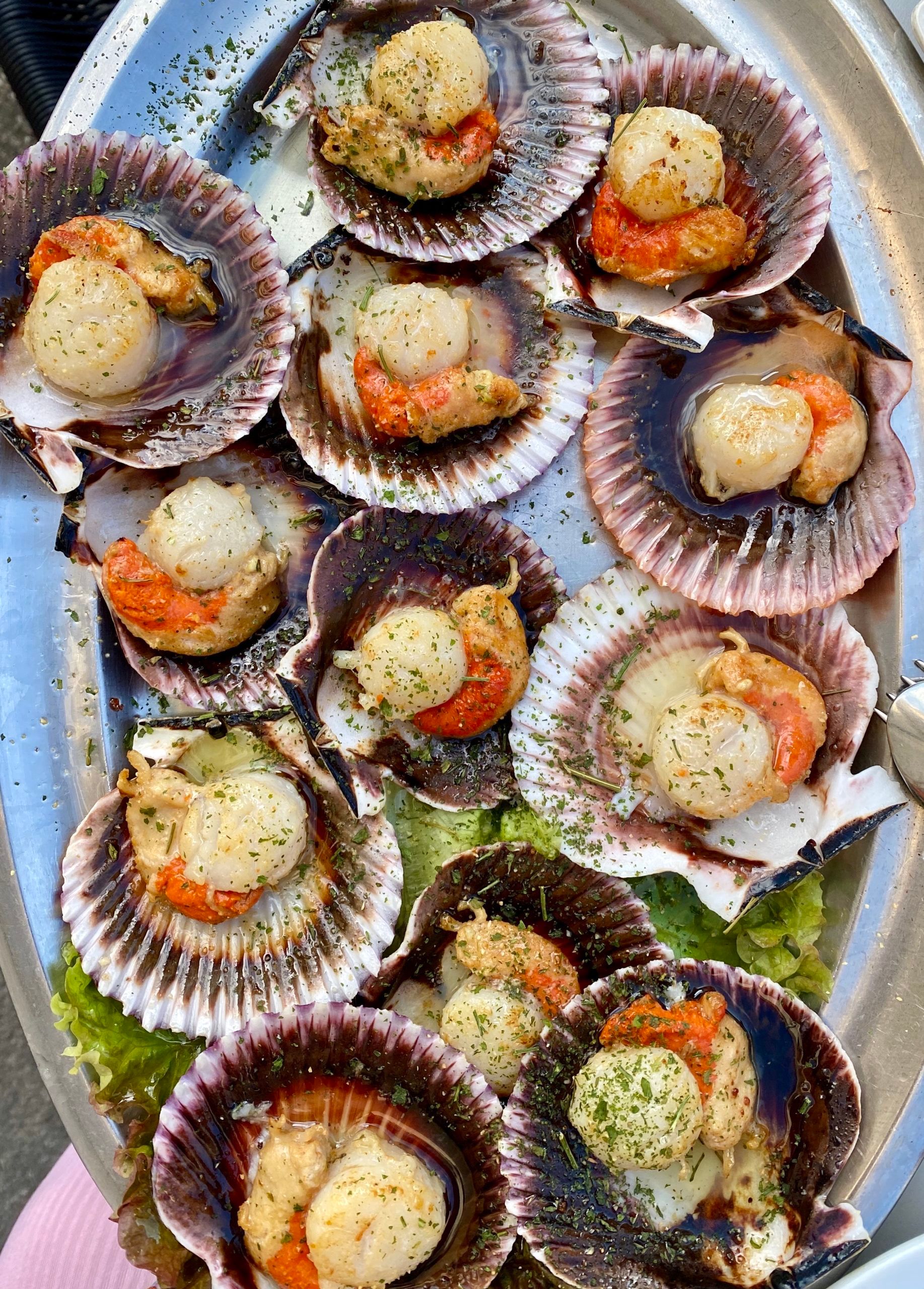
We sacrifice another sunset to eat dinner on the bathroom floor, entirely too close to the bidet. But we value Vahla’s restful sleep so much that we dedicate the entire hotel room to her.
On Day Five we hike 11 miles to Pontevedra, the second-largest city in the Galicia region. It’s old quarter's narrow, pedestrian-only streets remind me of Florence. Most of the route between cities cuts through a fairytale fern gully with babbling brooks and rocky scrambles. I feed an apple to a roaming horse and he tags along as the fourth member of our troop for a hundred meters. It’s early October and we’re enjoying that magical first week of fall with just a hint of bite in the air.
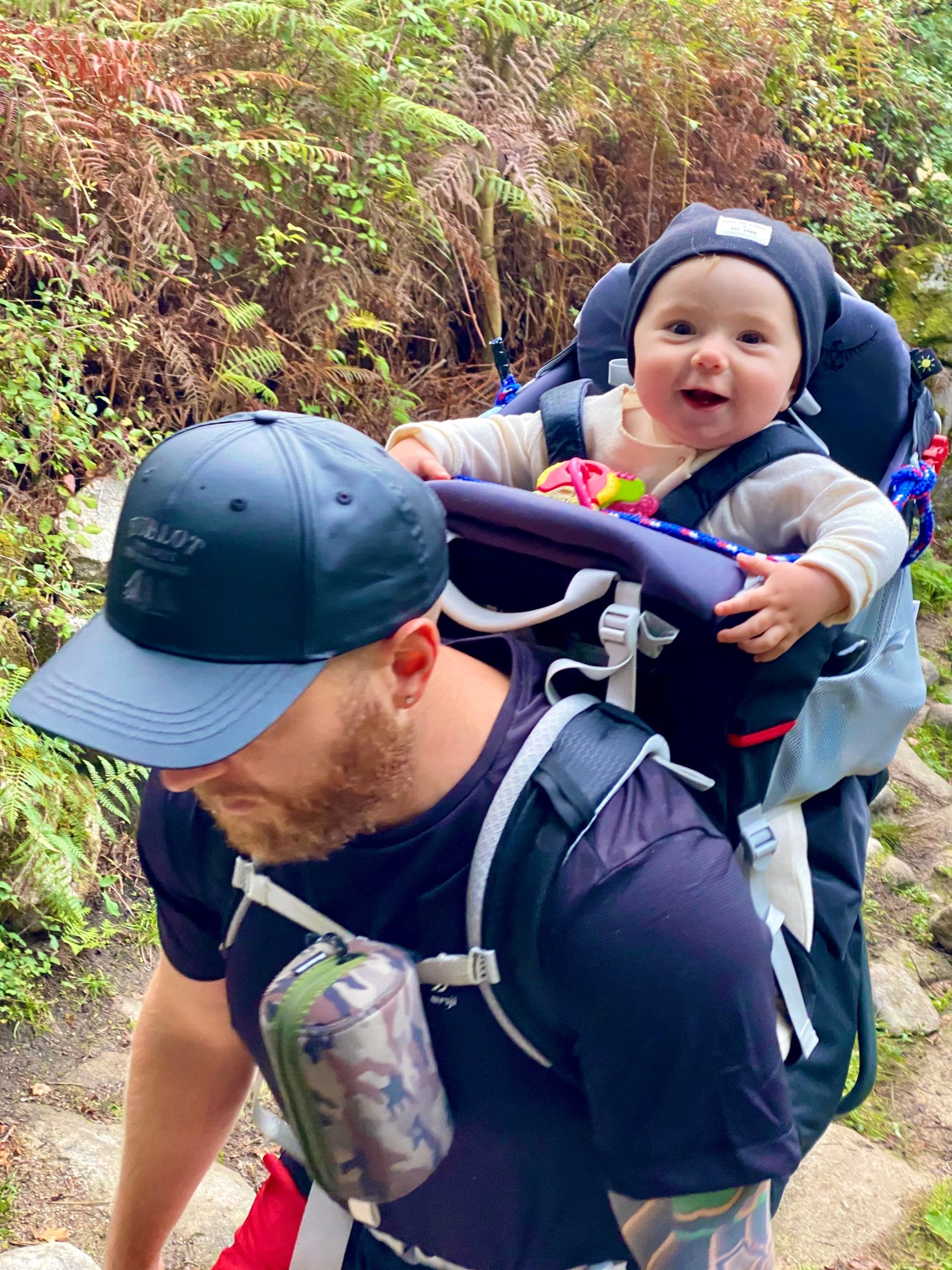
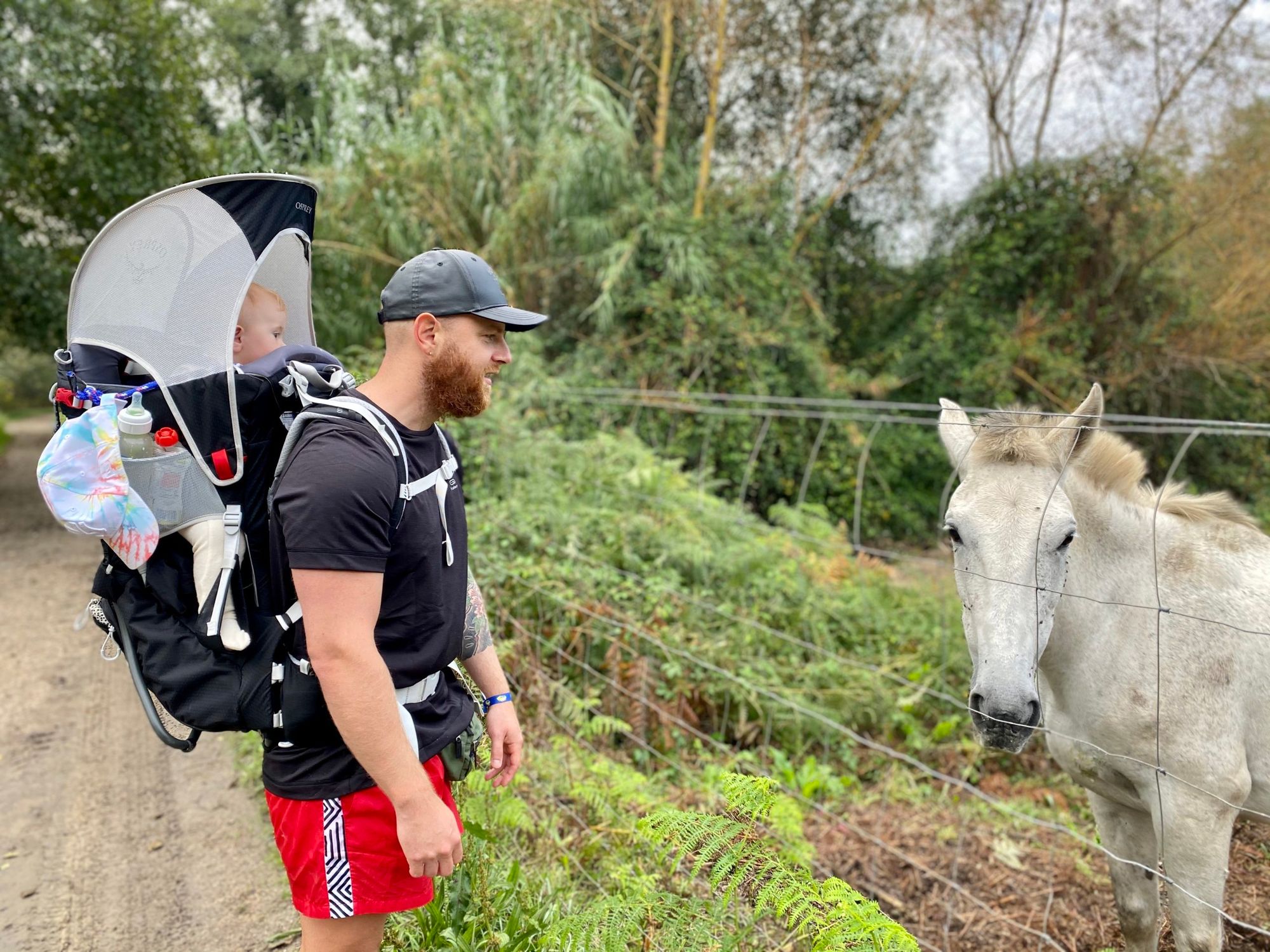
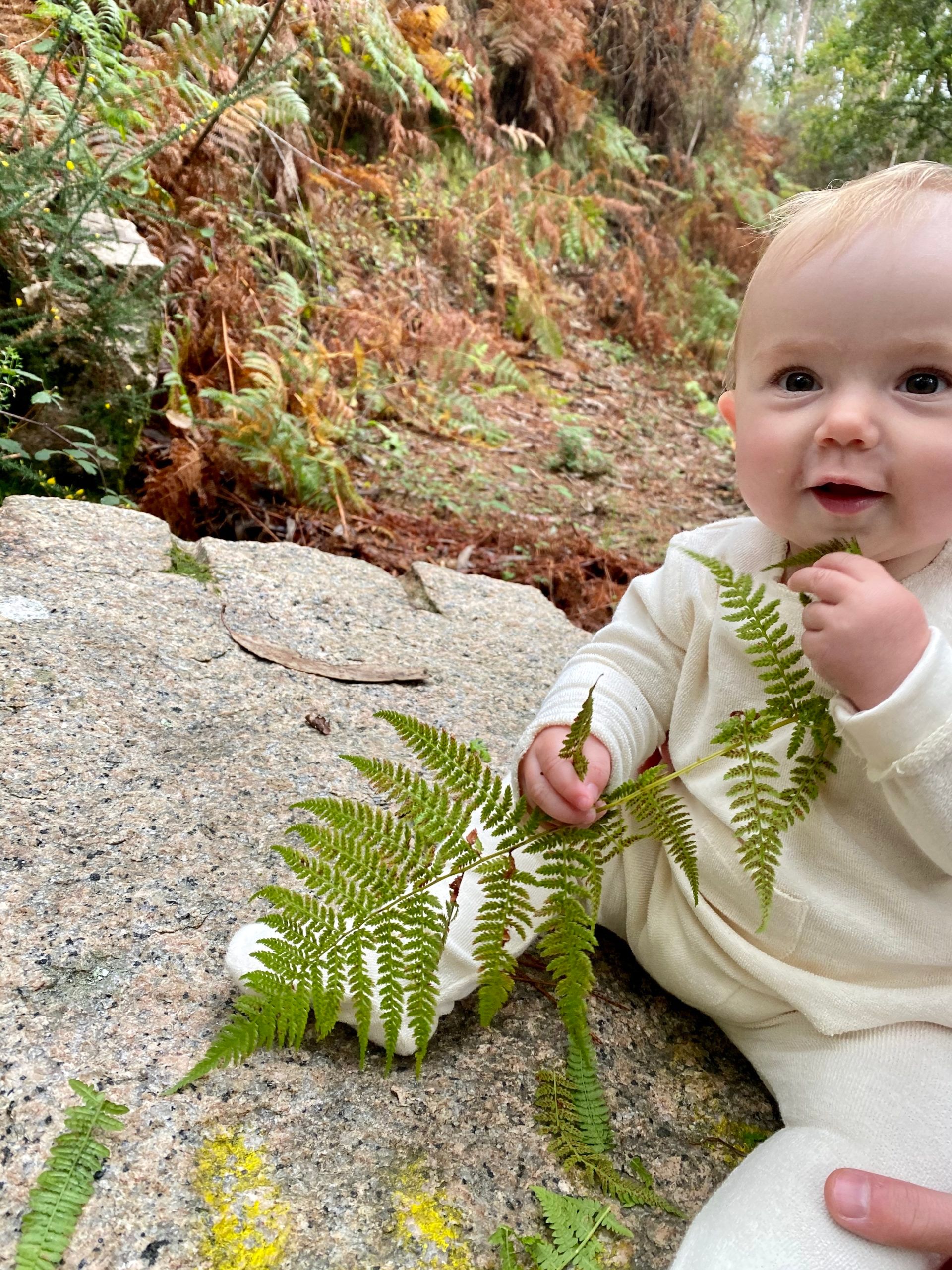
We finally curb our excitement to keep marching on by stopping for tapas at the side of the road and the last section of the day traces a busier road past country houses. As we enter the city, we’re immersed in a crowd of people larger than I’ve seen this entire year. “It must be a holiday!” Erin reasons. We are staying in another Parador, the former residence of the counts of Maceda. We picnic on the terrace and keep an eye on Vahla as she rips at the grass while we admire the setting sun as it bakes the stone buildings.

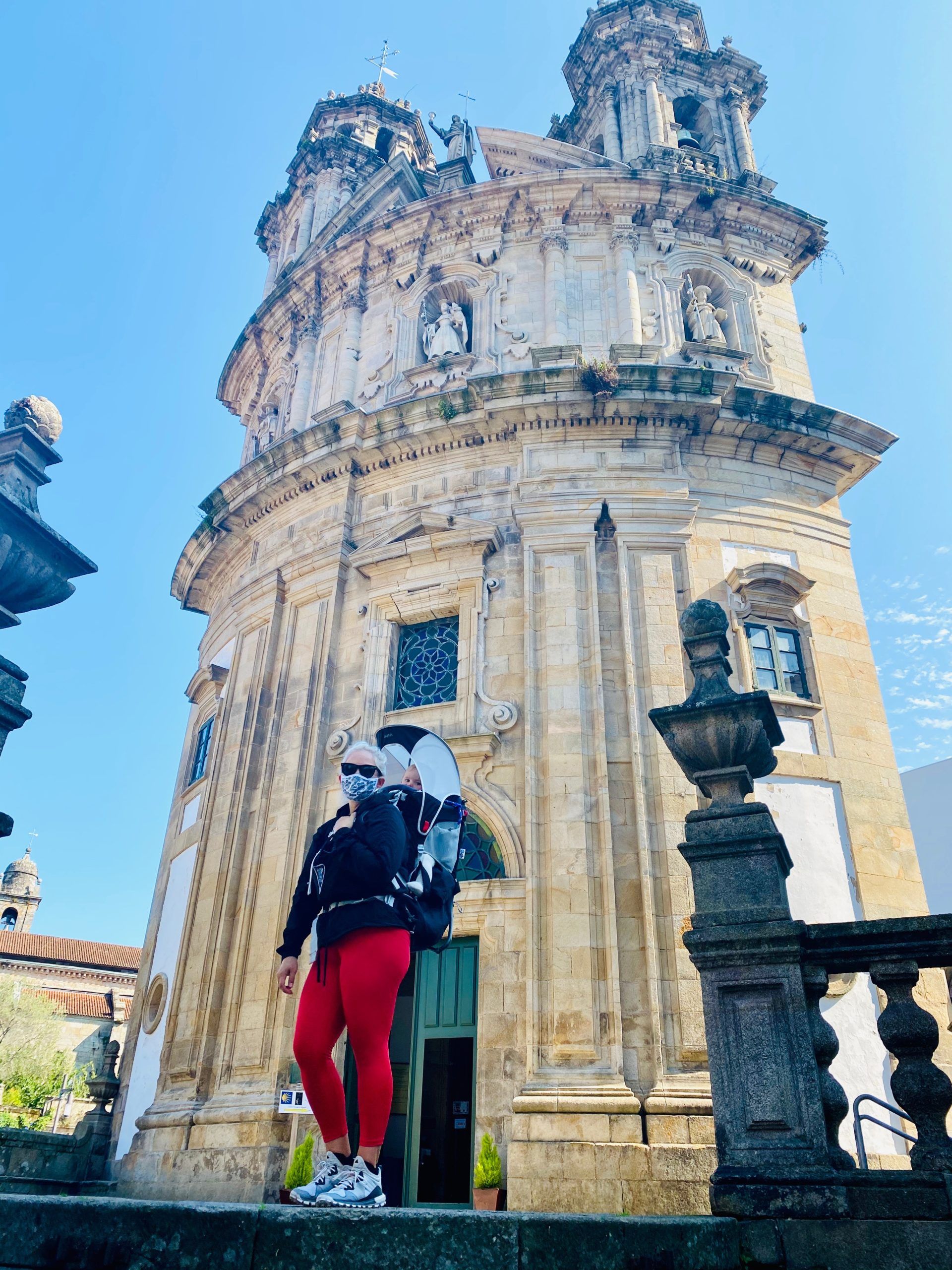
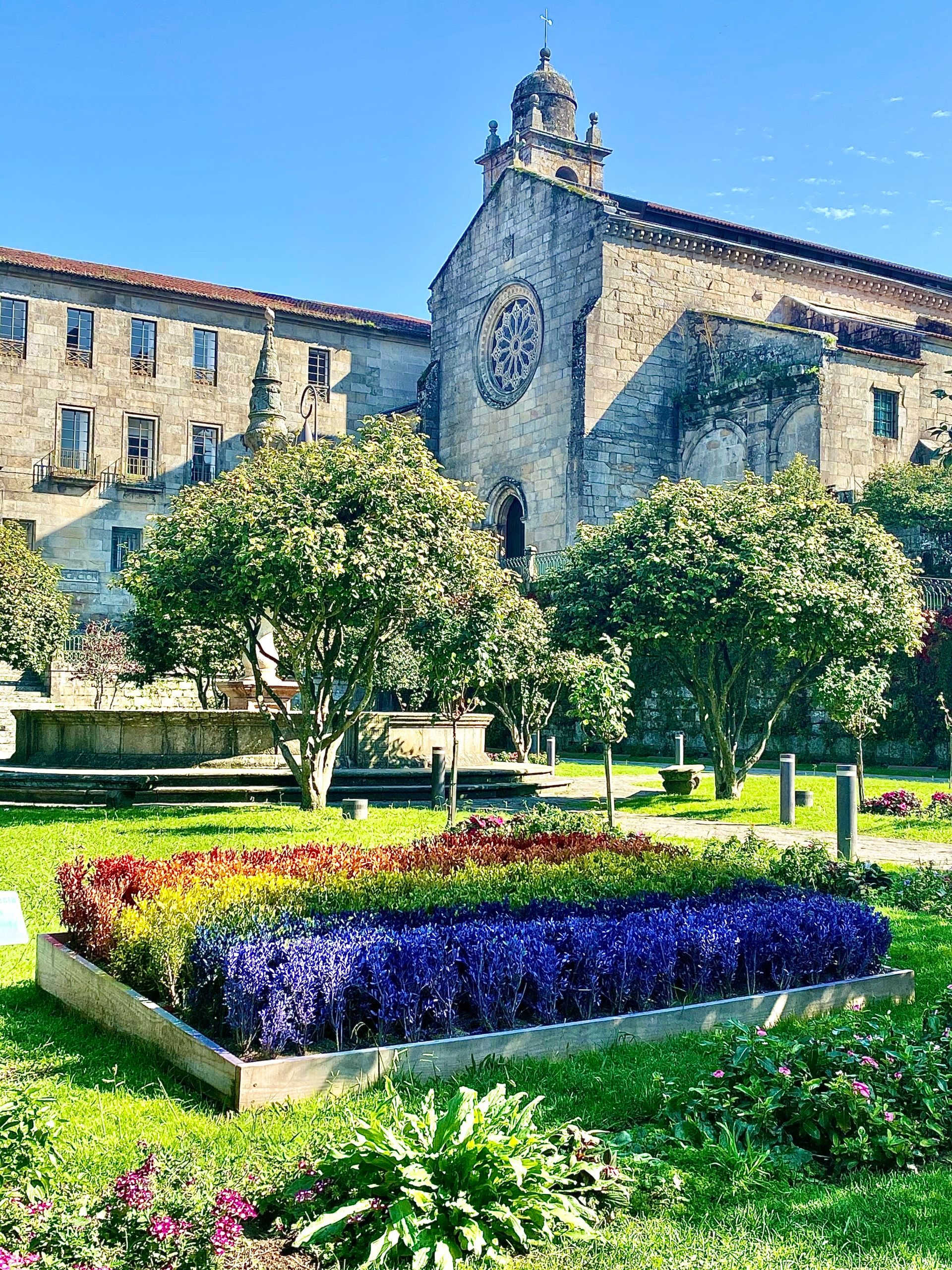
Vahla’s bedtime falls exactly during the town’s siesta period, so it’s impossible to order dinner anywhere in the vicinity. So we share snacks on the bathroom floor and review our best shots of the day.
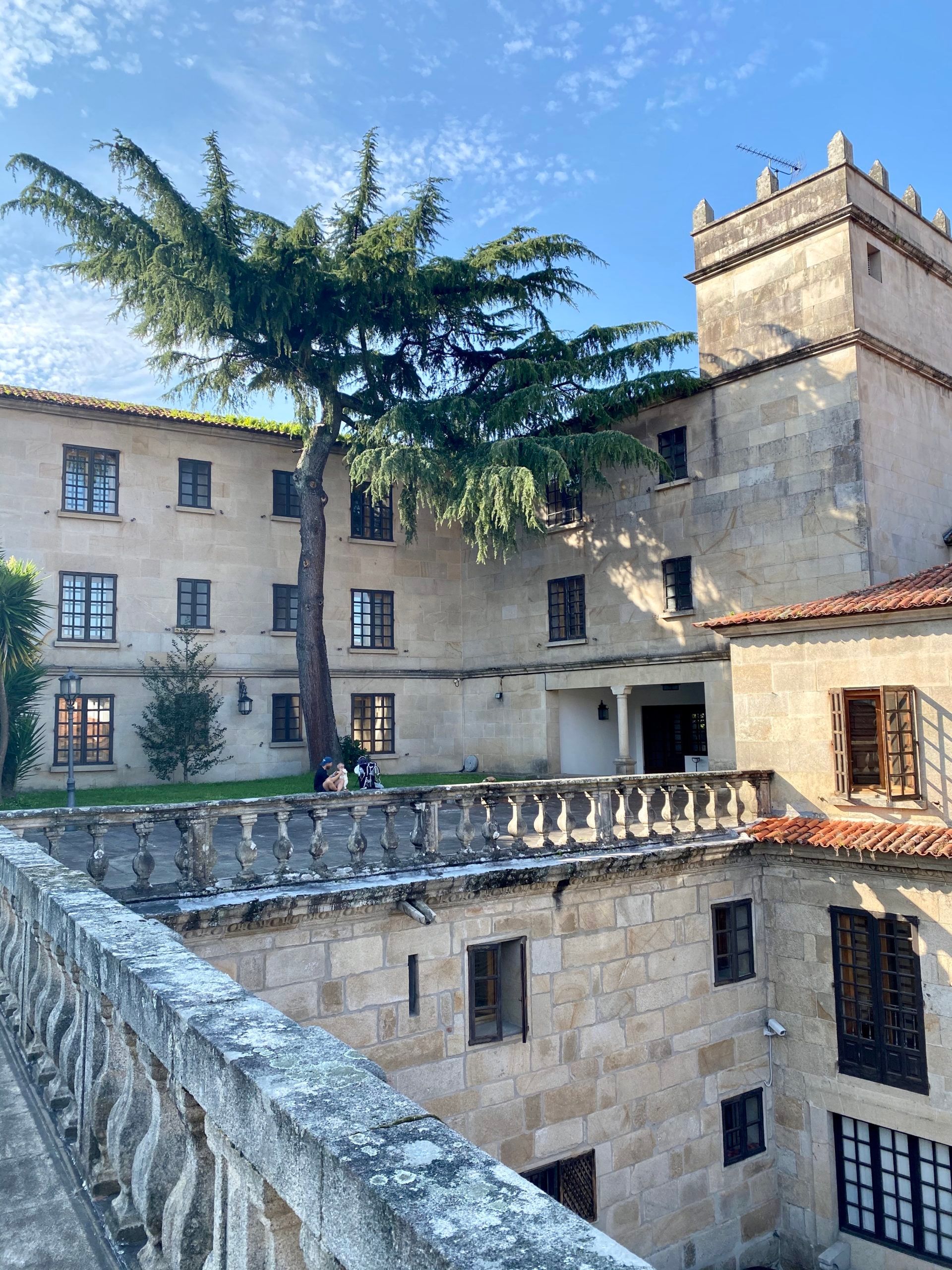
“Oops. Do you want the good news or the bad news?” That’s not what you want to hear from your hiking partner, but we didn’t realize until the night before Day 6 that we had forgotten to carry the one in our calculations and what we thought was an 8-mile hike would now be 15 miles. That’s the longest I’ve ever hiked in one day even without a 30-pound baby carrier on my back. And of course, Vahla’s second tooth decides to bud at midnight - that’s how life works, you get your worst night’s sleep before your most important days. But these types of obstacles are what the Camino is all about. It’s a vehicle for you to transform spiritual pain into physical pain - to learn about it and release it. During the most challenging moments, I have my friend Justin Rogers and his fight against ALS on my mind. Justin’s courage and most of all his incredible sense of humor in the face of adversity inspires me through the pain in my body. And he’s part of my “why” for doing this - I just have to do it while I can. [You can help Justin and 30,000 other Americans fighting ALS receive treatment by visiting justinsalsprayer.org.]

Although we started our journey on the coast, all roads to Santiago eventually become one, and we are now merging with other trails, including the most popular St. James Way. We’re seeing more pilgrims at rest stops and I haven’t sensed this type of communal positive vibe with strangers since I attended outdoor music festivals in California. Another pilgrim who has been on the trail for weeks is shocked when she notices Vahla’s face within my pack. “A baby on the Camino?”
Due to COVID’s travel restrictions, it’s safe to say that we’re the only Americans walking right now, which makes cultural differences stand out. At our first stop 5.5 miles in, a middle-aged pilgrim at the next table over shoots Vahla a smile and then proceeds to chain-smoke through her meal. I stare at her like she is one of the giant black slugs that we skip over on the trail.
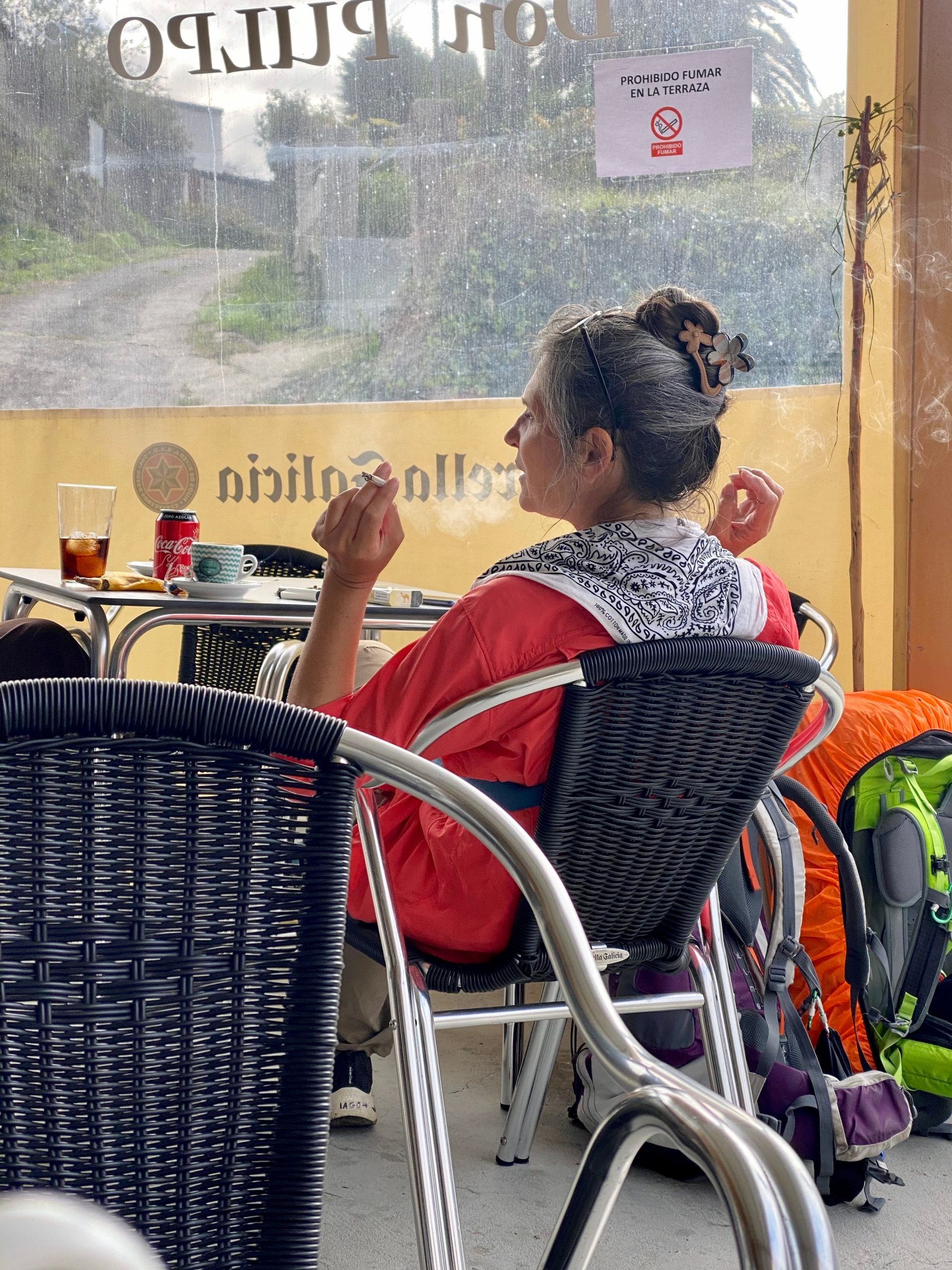
When a fellow pilgrim asks me where I’m from, I hesitate to say “America” because the US’s role on the world stage is anathema to what I believe as an individual and, simply put, it’s embarrassing. I believe that nationalistic, right-wing ideology that empowers the richest, abandons the environment and emboldens racism is an ugly reflection of humanity and I don’t want to be lumped in with people who are living in a reality that I find so contradictory. I consider where I’m from to be where I live at the moment because I see myself as a global citizen. I’m not rooting for one country to be “the greatest” at the expense of others. The political divide in America has made me feel like an outsider, a minority thinker in my own country for the past twenty years. On my travels, I have questioned admitting that I am American out of safety concerns, but never before out of feeling ashamed.

We descend from the country road into corn stalks and vineyards, where the overhanging vines make a patchwork of shadows over the gravel ground. Erin sings a thousand refrains of “Twinkle Twinkle Little Star” to keep Vahla entertained while I point out the gatos scurrying about the farmhouses.
Our entrance into the historic spa town of Caldas de Reis is spectacular but regretfully rushed. Anxious to unload at our hotel, we cruise right past a picturesque waterfall that hushes below a shaded cafe. Before we know it, we’re racing out of town and up a steep highway road. There’s no shoulder and it was clearly never intended for pedestrians. Yet, we’re adamant about sticking to our commitment to only walk the Camino. After 15 miles, we gratefully reach the Torre do Rio, a beautifully restored 18th-century textile mill. Without even changing, I follow the sound of the rushing river straight into the natural pool that features its own waterfall. Erin and I trust that the chilly water will relieve some of our soreness, although the staff can hear our “wooo-hooo” hooting from three stories up.
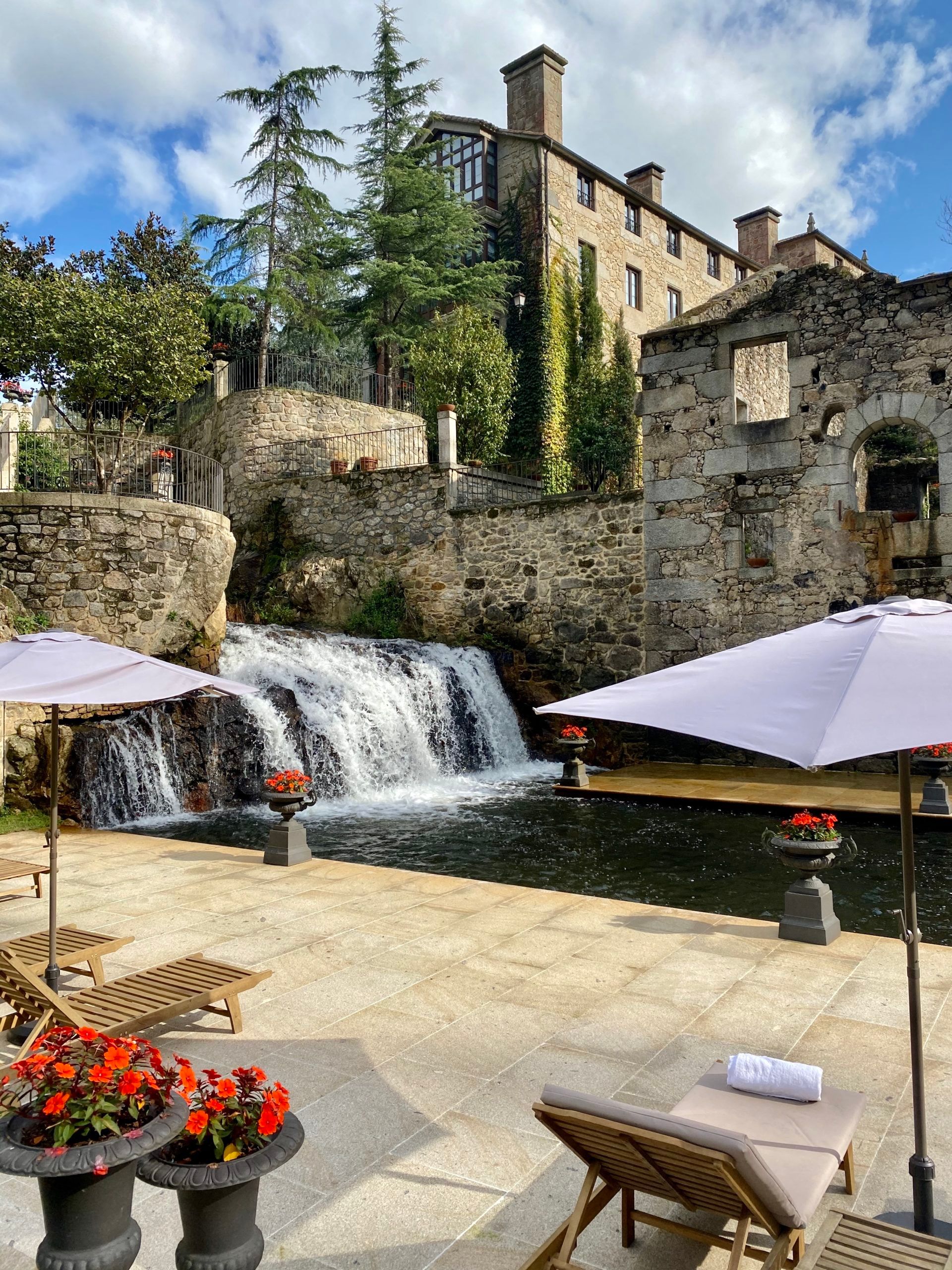

What a way to hit a milestone! Vahla stands up on her own for the first time today at a chicken coop under vineyard trellises in the Galician countryside. She’s wearing Erin's plaid shirt that her mom has been saving for 35 years. It reminds me that, although our path this week is a straight line to Santiago, life comes around full circle.
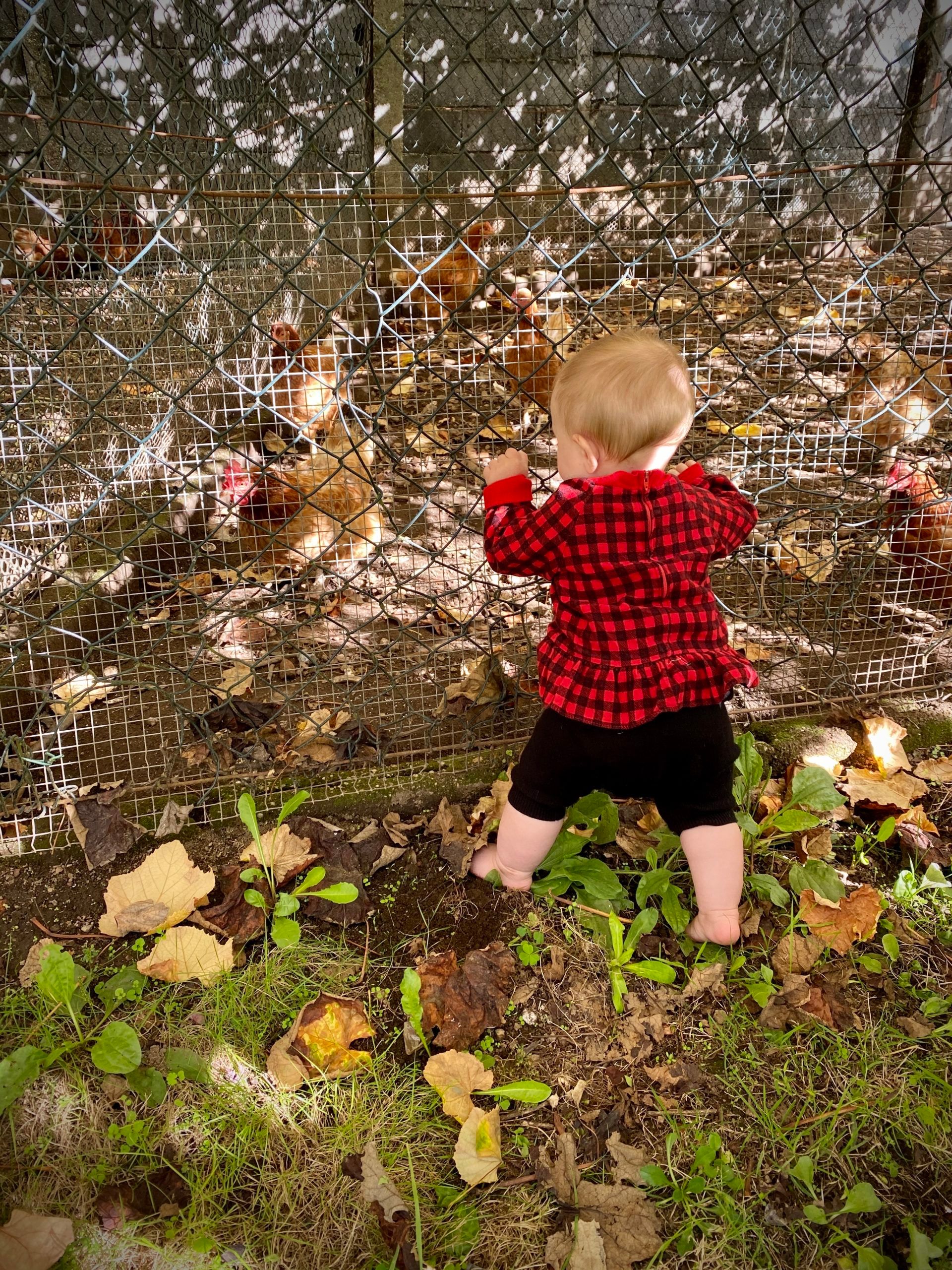
“I’m living the life of a fancy vagrant.”
We’re a week in with 80 miles behind us and I’m not getting tired of this experience at all. It’s a tiny glimpse into the expedition lifestyle of some of the world’s greatest polar explorers that I’ve interviewed for TOJ, like Mike Horn and Borge Ousland. As I’m getting closer to the end, pain turns to exhilaration. With that excitement comes a bittersweet feeling that the end is near. We kick it in gear to pass a group of five and savor the satisfying gravelly crunch underfoot. On our path, the verdant forest soaks in the sideways sun as the wind rustles up that chilly fall morning smell. Avalanche charges explode in the distance every other minute, releasing a puff of white smoke just above the trees.
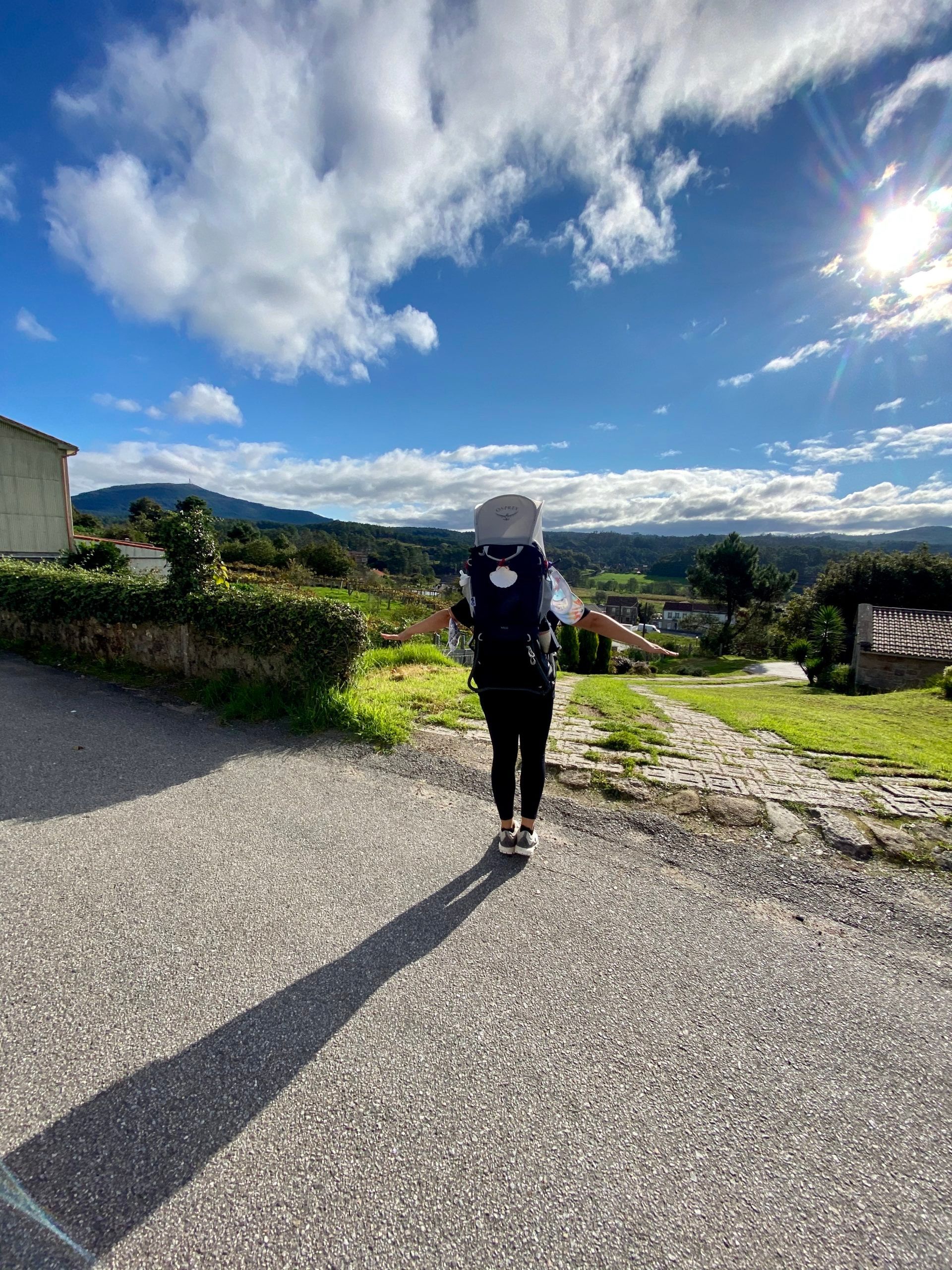
Vahla takes a nap in the baby carrier right on time, which means she is either adapted to our routine of walking from 8 am to 3 pm, or she is exhausted. We savor our rest stop on a vineyard. Their local wine is served in a bowl and it tastes like fizzy, white grape juice - delicious! We share tortilla and a croissant as Vahla joyfully rips apart grass and leaves. I’m getting used to living the life of a vagrant, a fancy vagrant.
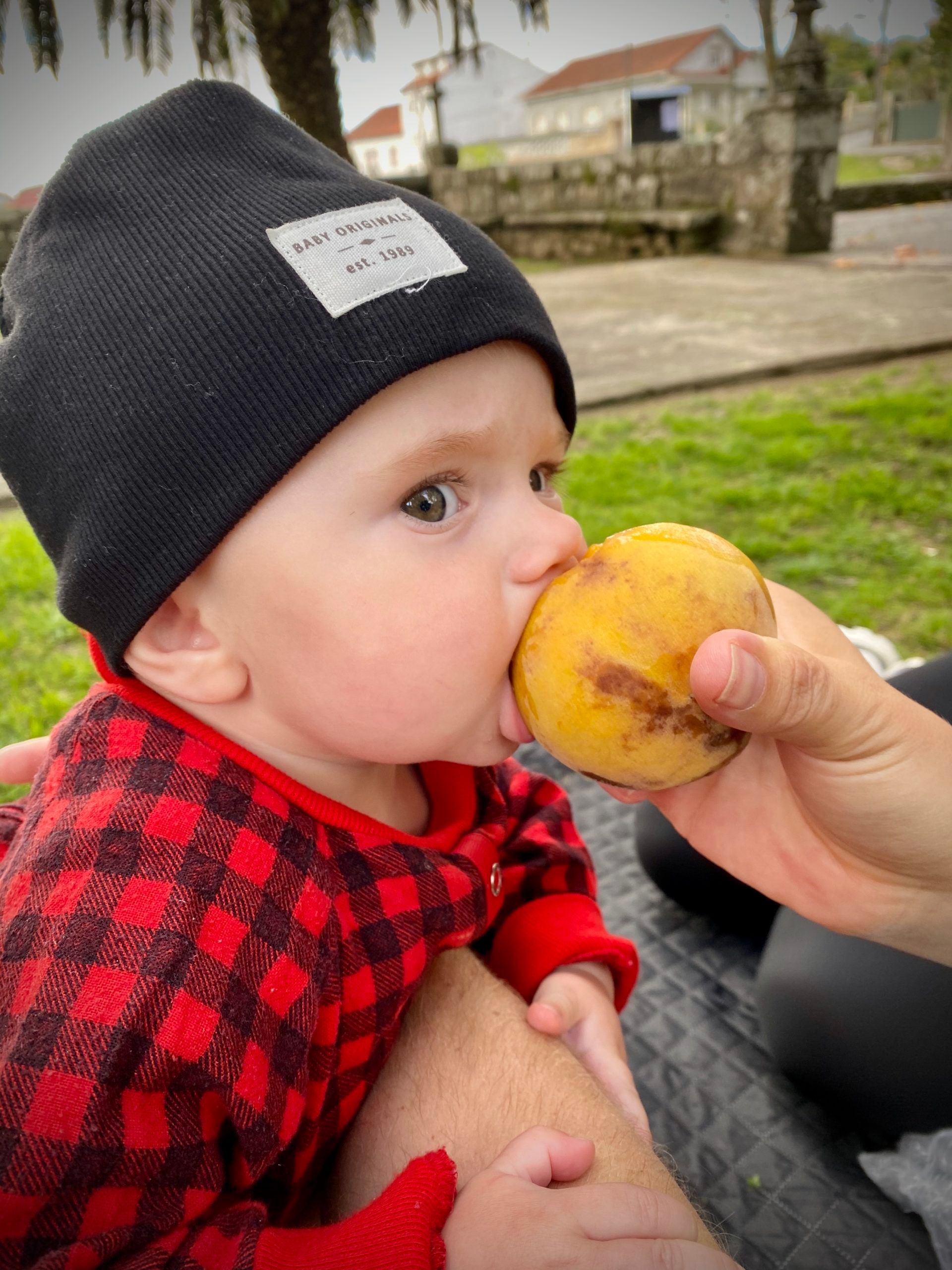
After hiking 14 miles through the day, we’re running out of gas to explore the town in the evening or even try to rustle up some semblance of dinner given the closed kitchen window during siesta, but thankfully our hostess offers to bring us a home-cooked meal made by her own mother. This chicken Milanese recipe must have been passed down for generations, as it feels very “old world.” It makes me remember that there is nothing like home-cooking.
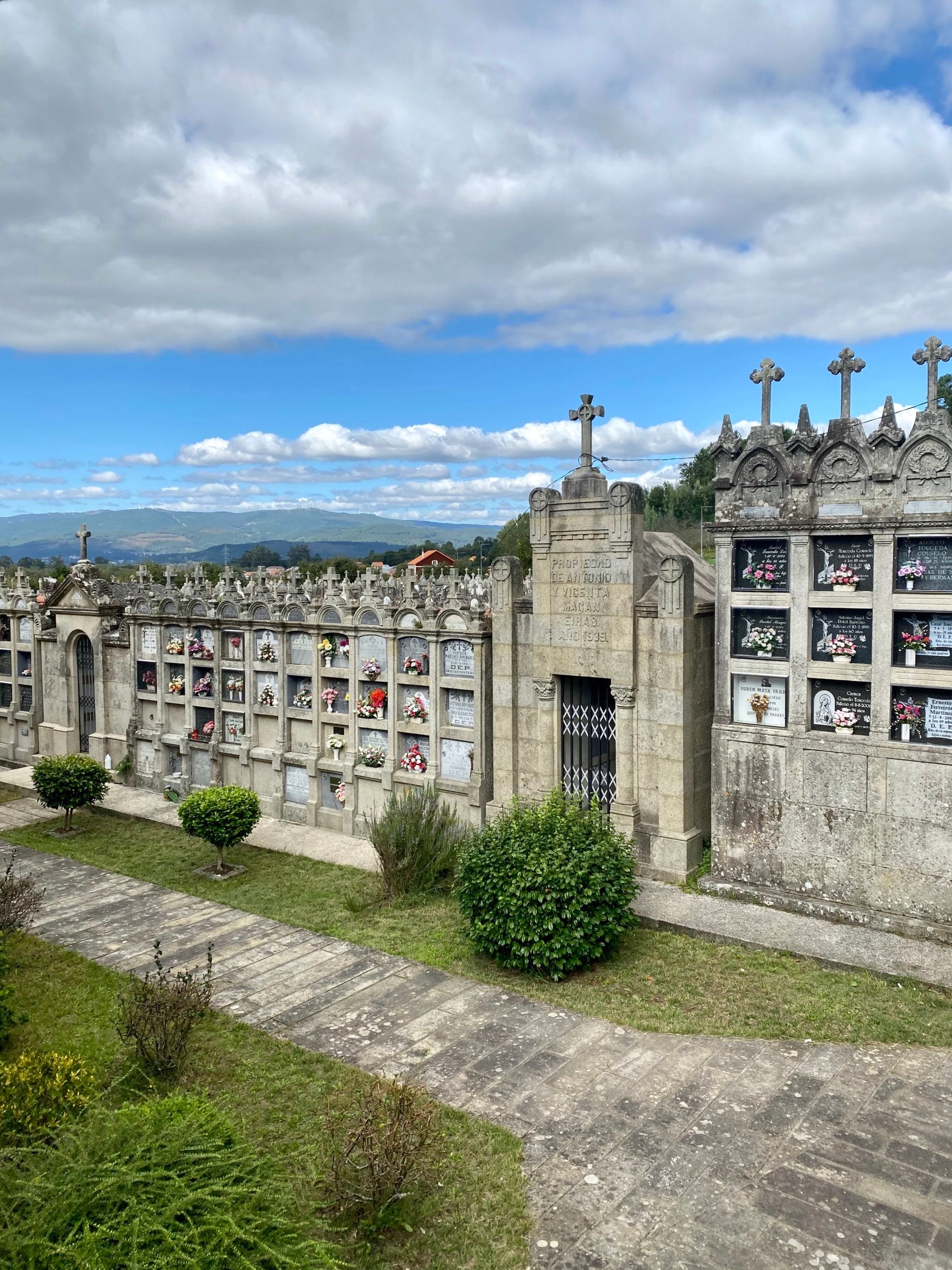
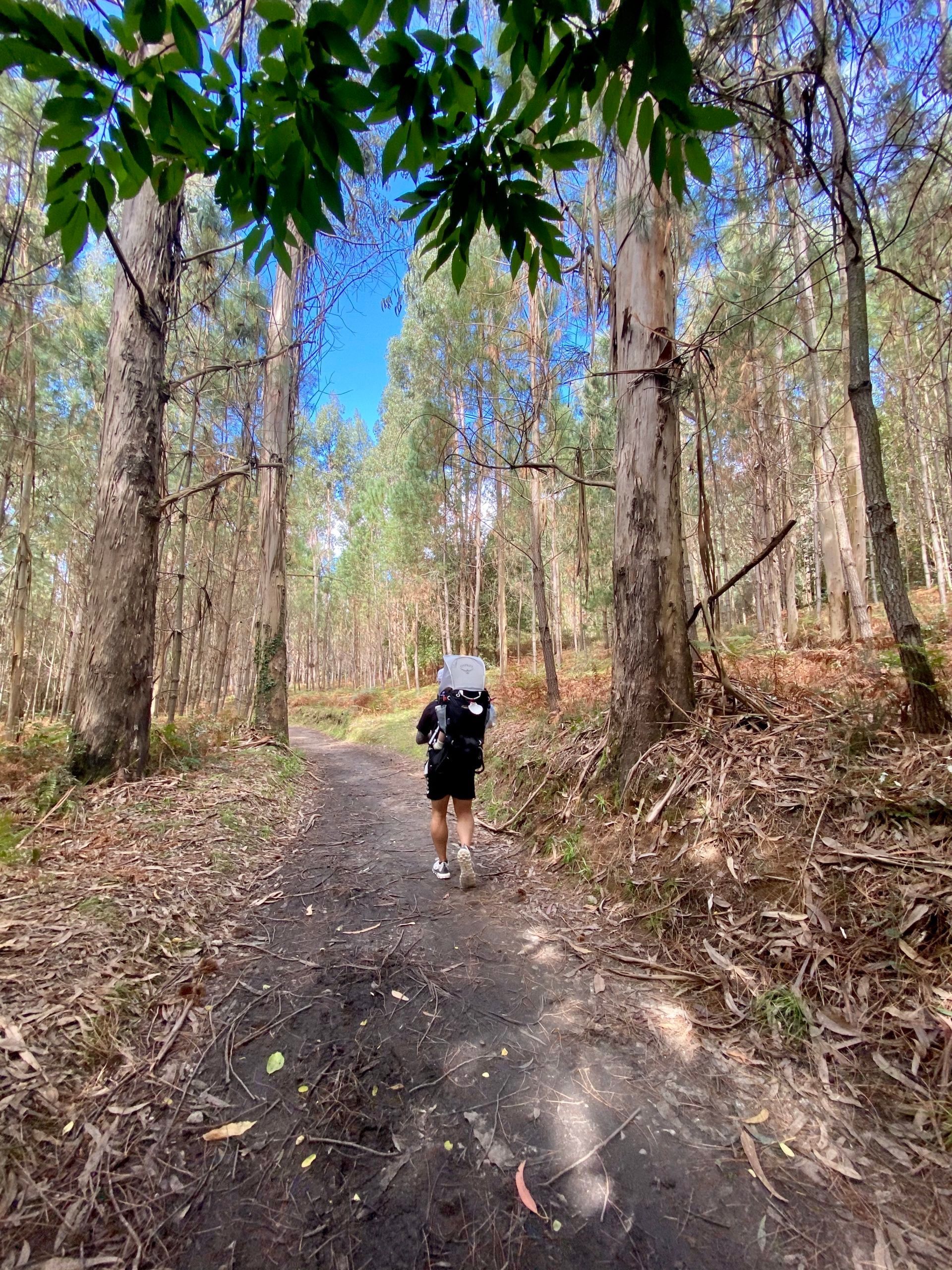
We’ve wandered 87 miles from our starting point and we’re only one more day away from reaching the Santiago de Compostela cathedral. I’m going to miss the simplicity of walking in the fresh air all day and following the spray-painted signs and markers. I’m noticing how walking all day is making me appreciate simple things that I used to take for granted, such as how that first meal tastes, how that first shower feels, and how good it feels to finally let my head hit the pillow at night.
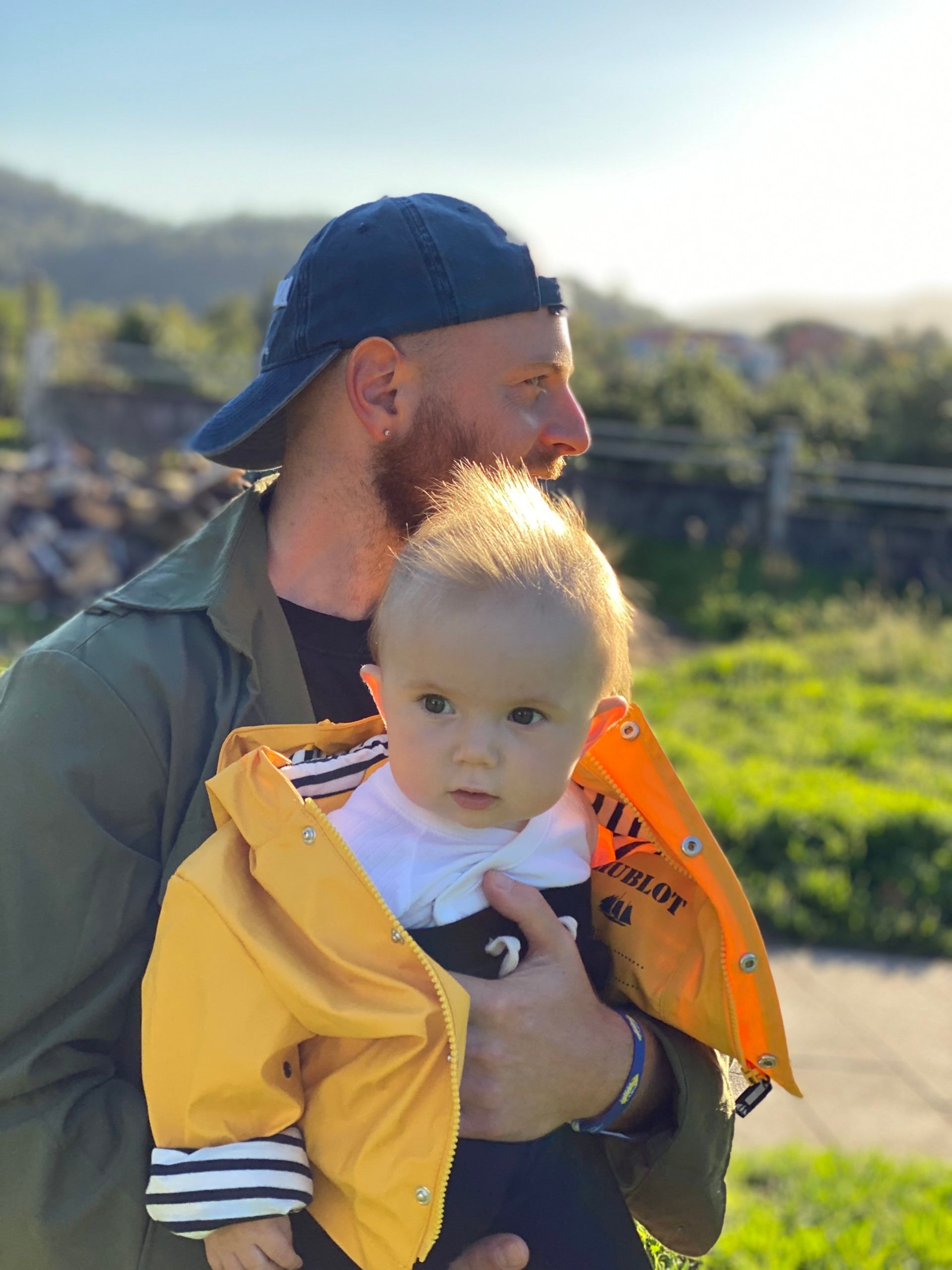
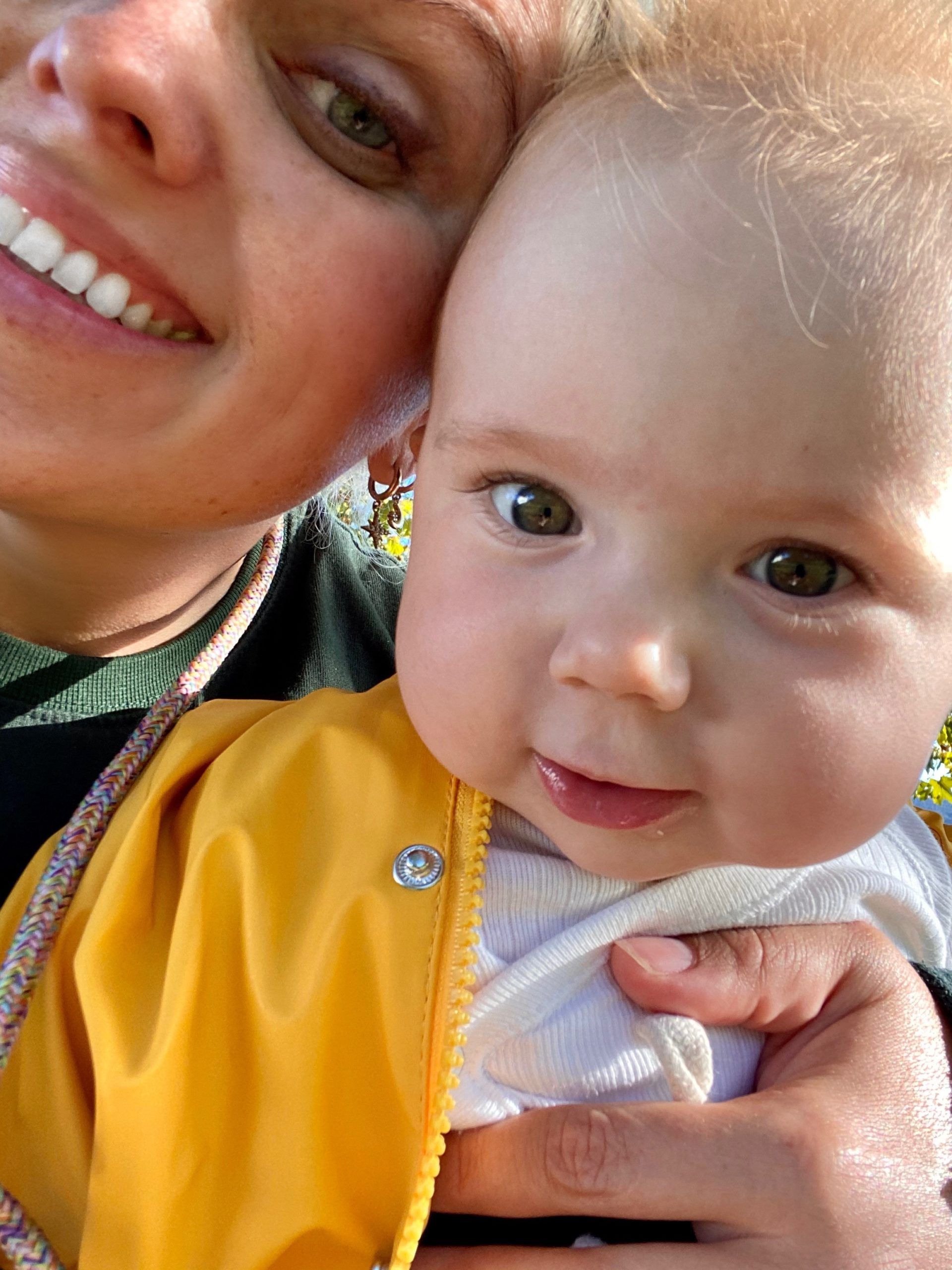
To start the day, we wind through a sleepy town in the morning to the smell of freshly fallen leaves. There’s no activity at all except for the cats darting about. We set up a picnic in a churchyard and eat churros with local churchgoers. They are mostly elderly folks and, without fail, they wish us “Buen Camino!” Authentic Spanish music from a far-gone era plays in the background. The people running the cave-like market underneath the church are shocked to see Vahla riding inside our baby carrier.
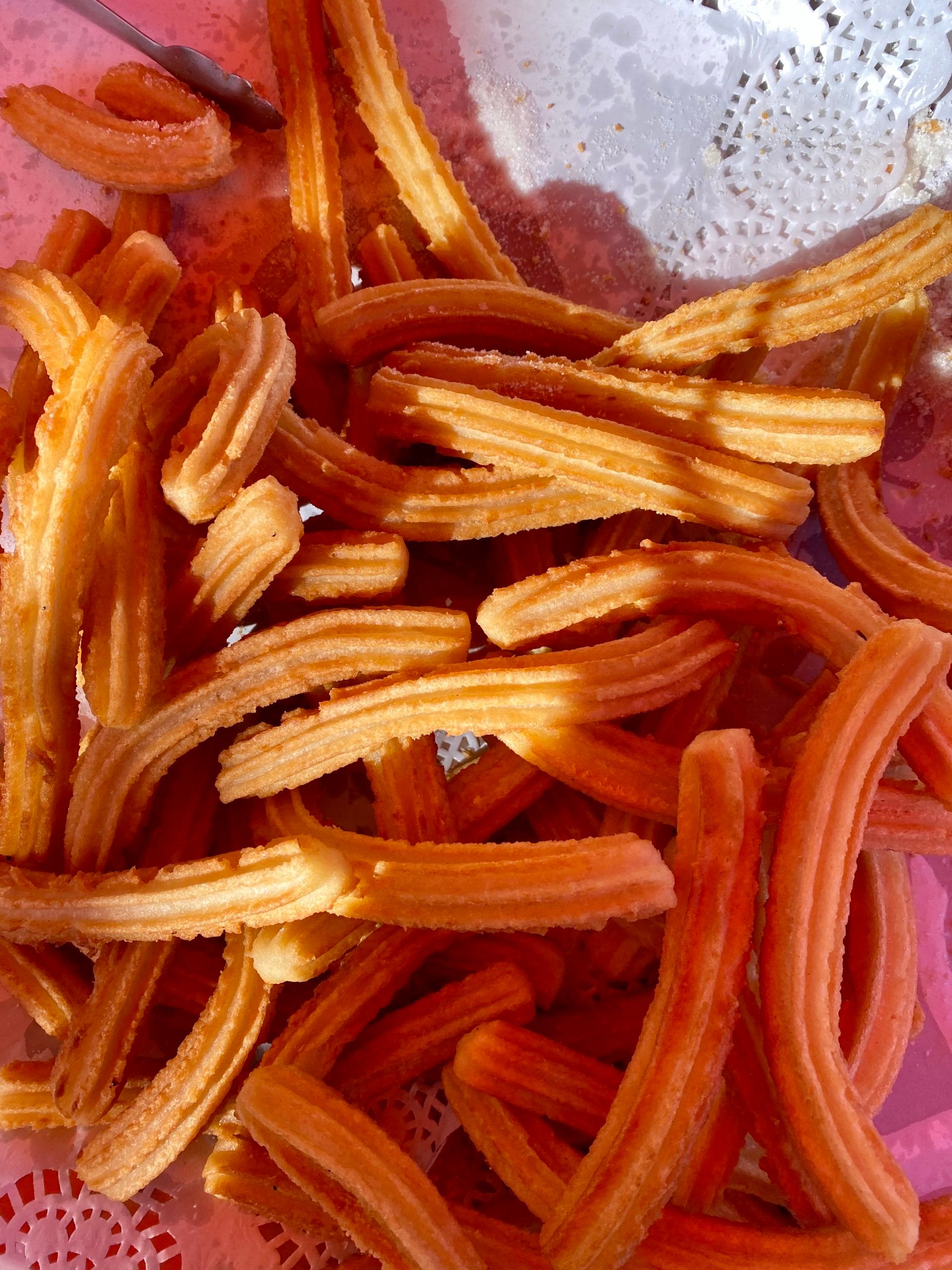
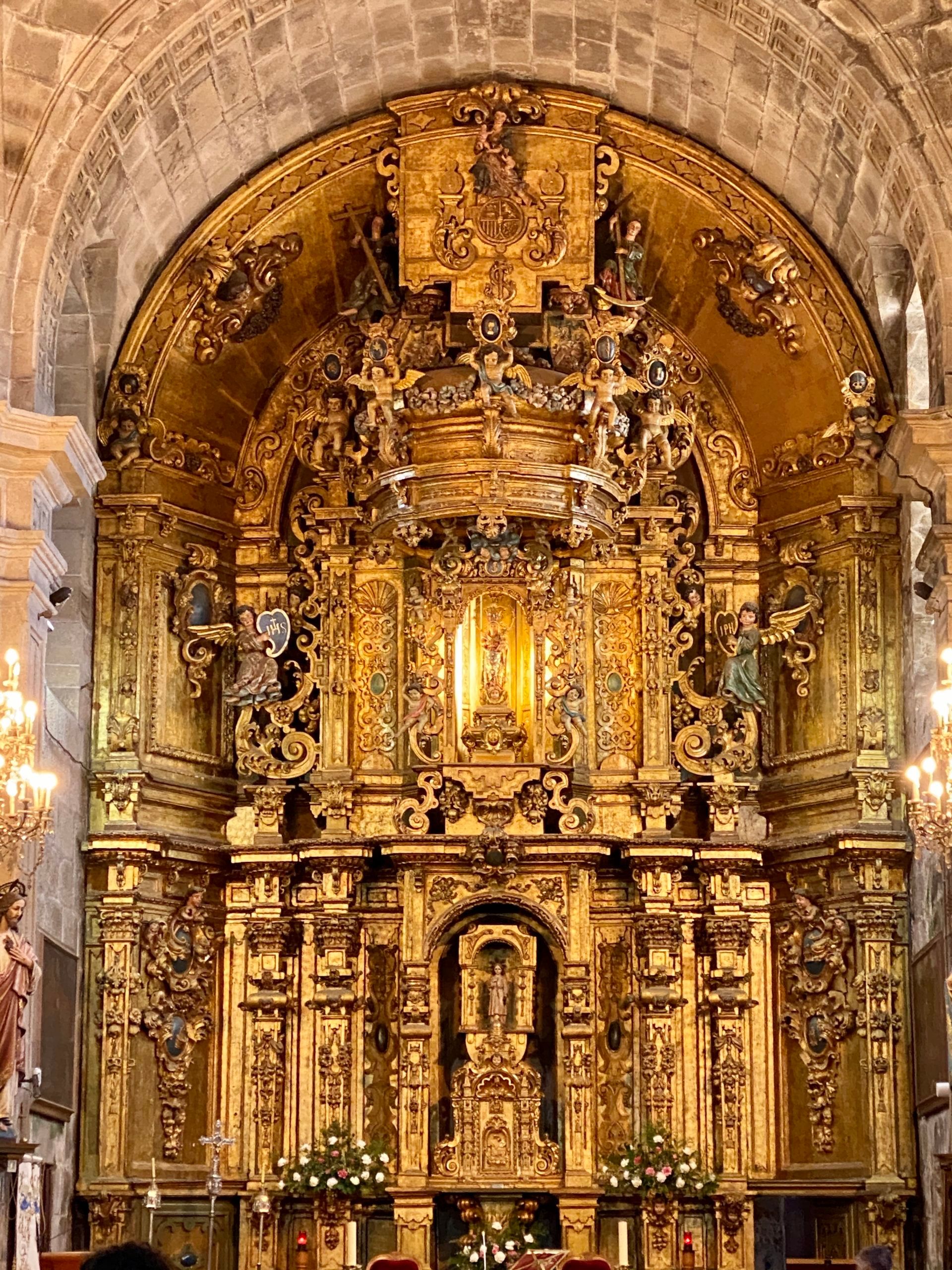
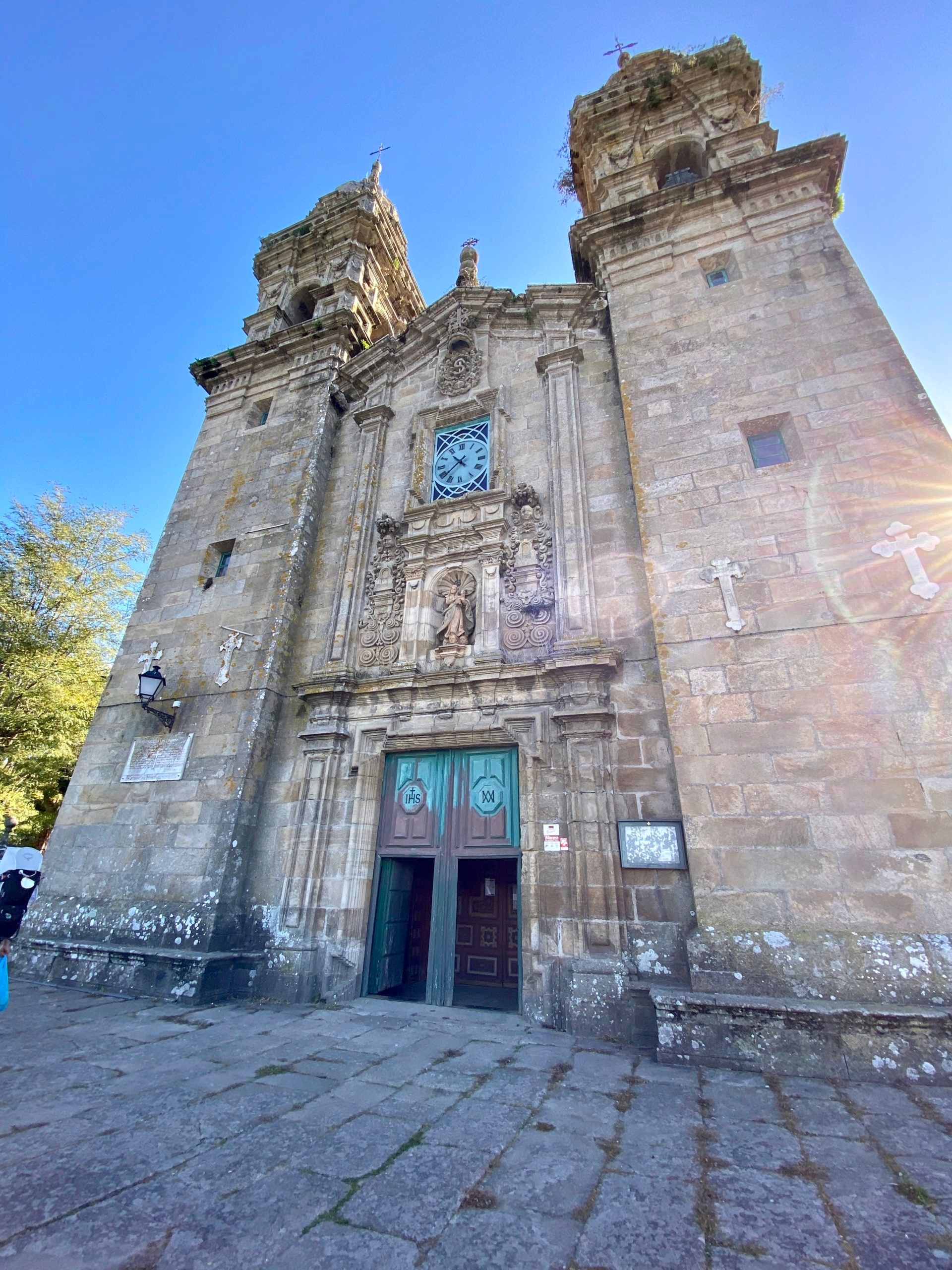
We check into a two-story farmhouse for our last night and enter through a barn-style door. A spider the size of my palm is mounted motionless next to the key-hole. “This is the country!” our host chuckles.
For dinner, lobster paella was brought to our countryside villa straight from the attached kitchen, which is a nice change of pace from our customary dinner on the hotel bathroom floor. Somehow we are able to crack open the shells without stirring the baby. Then, we silently tidy the plates up as best we can afterward because there’s no telling what other critters lurk in the shadows.
On our last day, it feels fitting to get started before sunrise. Pink hues alight the way towards Santiago. There’s no doubt that we’re going to make it now, so we stop for tea and a croissant to stretch out the day and delay the end of our trip. We catch our first glimpse of the cathedral towers on a sprawling hilltop from seven clicks out of town as we weave in and out of forest trails. As we draw nearer, the temperature gets cooler, like the cathedral has its own microclimate. It’s my first time putting on an extra layer more than shorts and a t-shirt in a week.
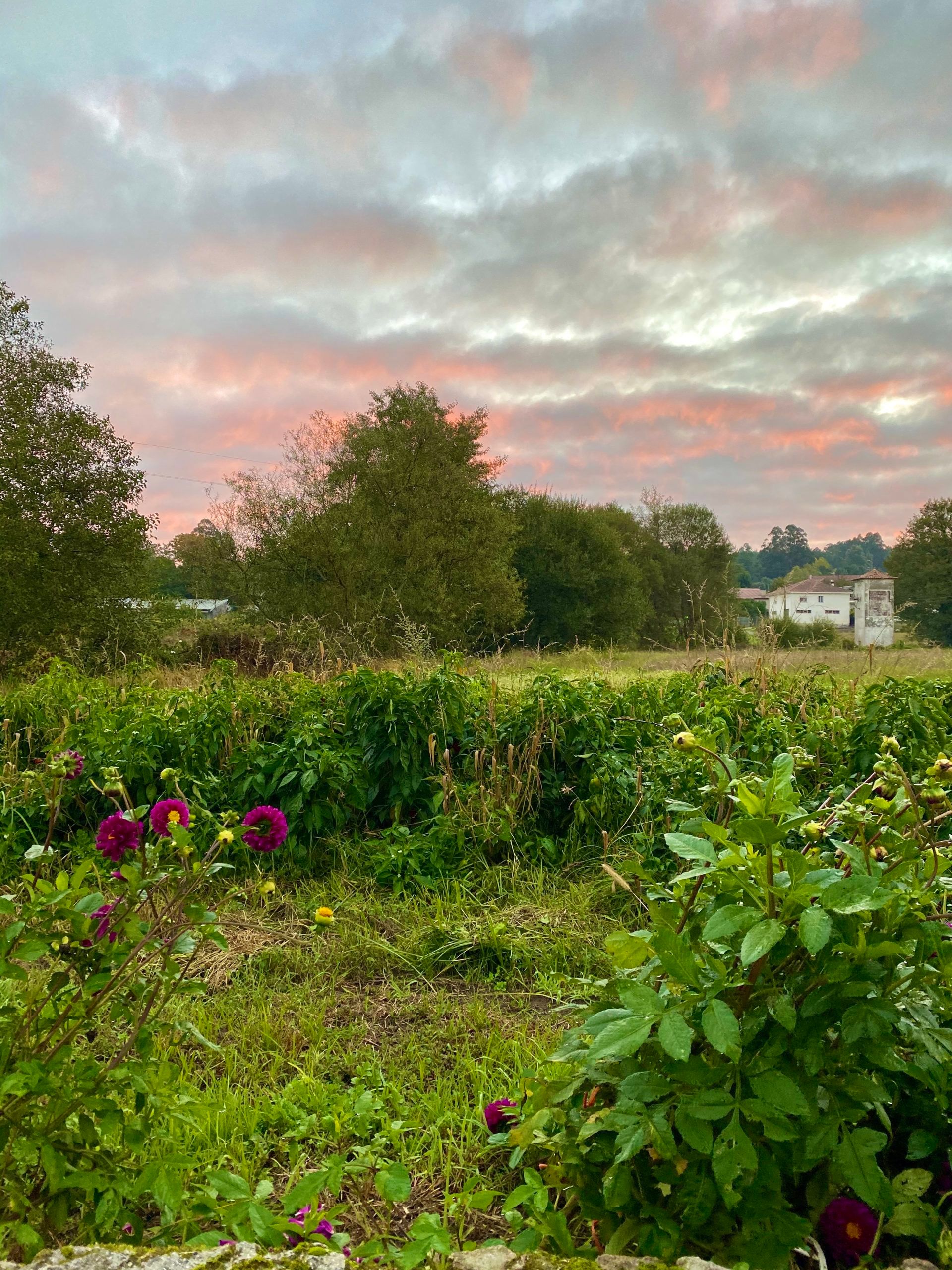
I’m impressed by how preserved the pilgrimage experience is, especially the final section leading to Santiago, which could be way more commercial. There are no vendors selling cheesy souvenirs. There’s no pomp and circumstance. It’s like we’re on a secret, back door entrance. I know I’m near the city, but surrounded by forest, I still feel immersed in nature. At the same time, a sadness kicks in as we approach the residential city zones, along with the realization that all of this used to be fern gully.
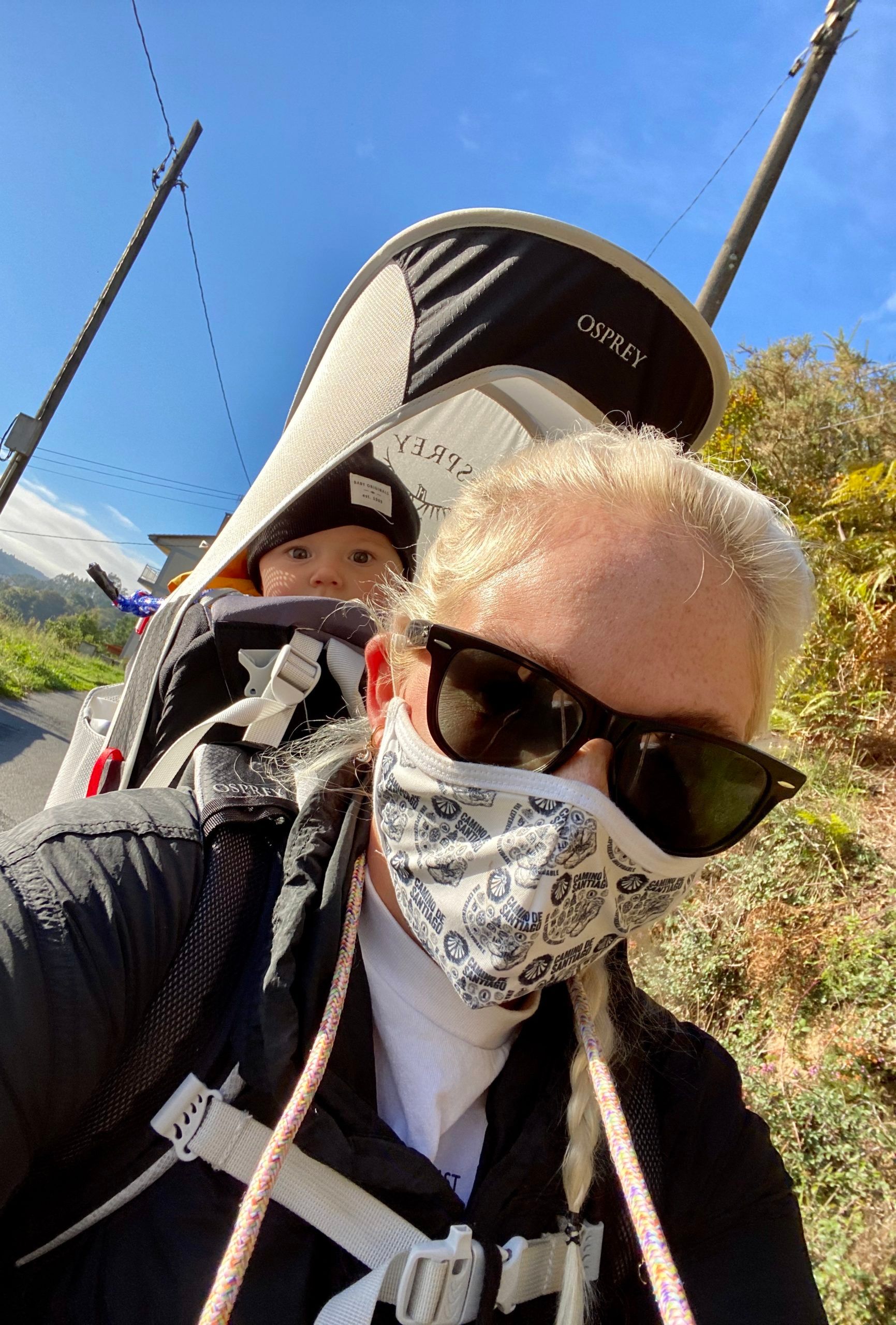
We march through town in a state of disbelief that we still feel this refreshed after walking 100 miles. We’re not sure if an unholy exhaustion is about to hit us or whether some sort of spiritual epiphany might change our perceptions of life. Finally getting the chance to explore the dimly-lit cathedral is a surreal experience. The weight of the golden ornamentations in each nave makes the cavernous cathedral feel underground, with millions of pounds of bedrock overhead. The answer to my question is nowhere to be found, because it's already been answered. Our journey was the answer. The birth of my daughter hasn't limited me at all. My days of exploring what this Earth has to offer are not behind me. The greatest adventure of my life is just beginning.
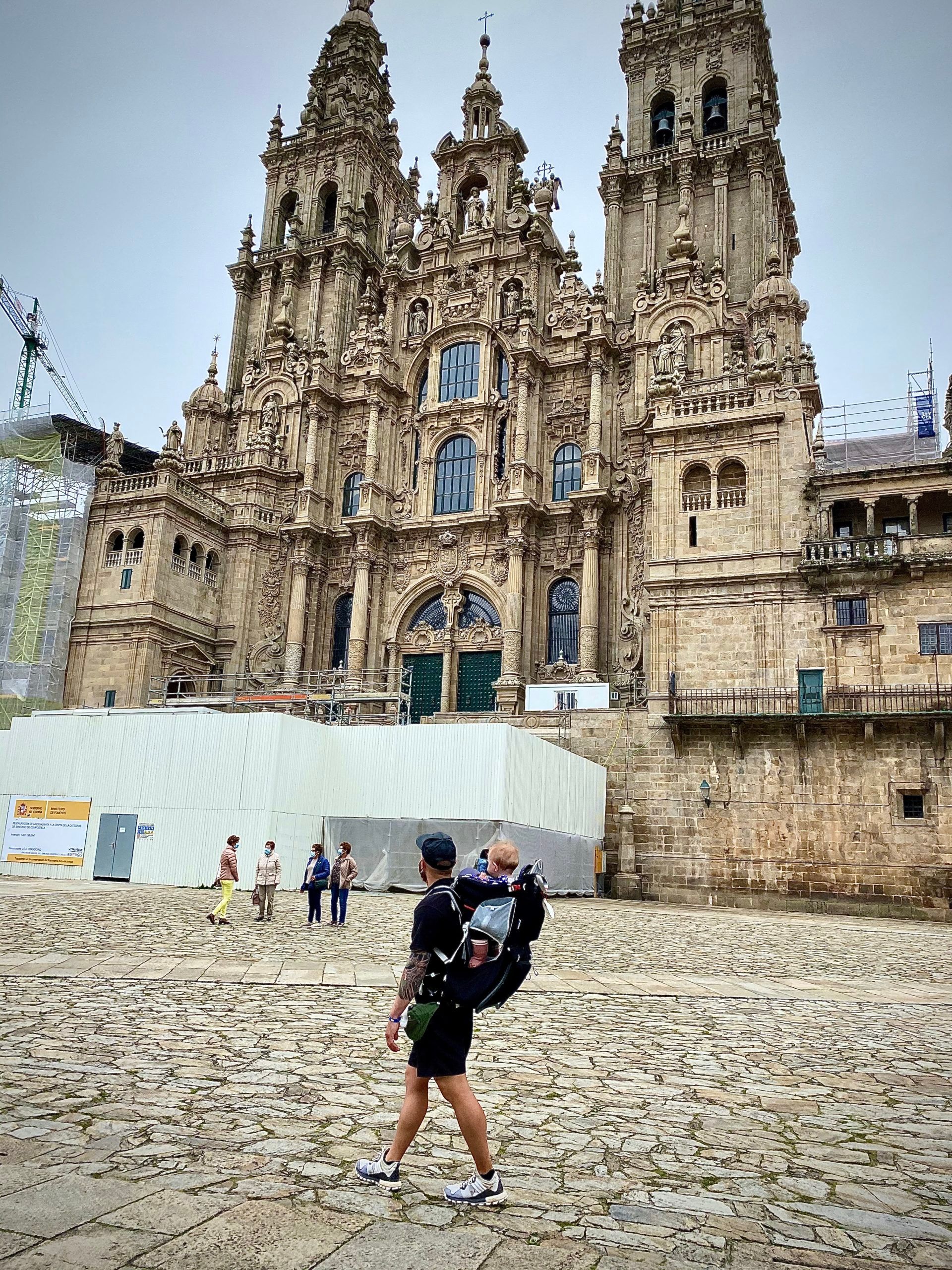
Over the past 9 days, we walked more than 100 miles on the Camino de Santiago from just over Spain’s border with Portugal to the Santiago de Compostela cathedral. Walking the pilgrimage path was a physically difficult challenge but it was also luxurious in the amount of time I had to think, to contemplate, and meditate as I walked. I reflected on the cosmologically impossible luck of finding a soulmate in life. Yet, if I found mine on the path that I’m on, and we had an extraordinary daughter seven months ago on that same path, then I can trust that I’m exactly where I need to be right now and I can trust that what lies ahead is all part of the same wonderful journey.
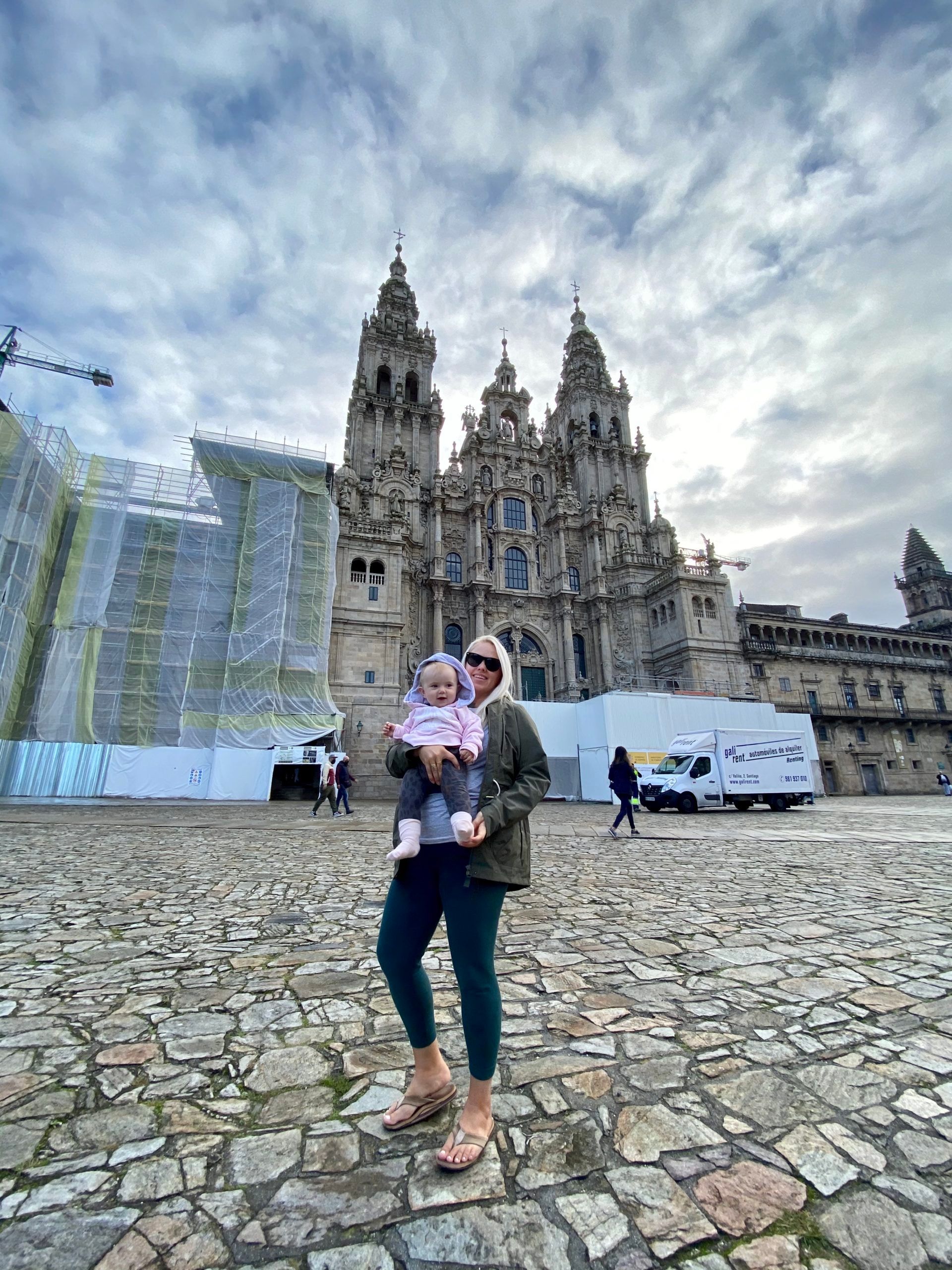
I could not have done this without my tough-as-nails and ever-curious wife, Erin, and my daughter Vahla, who has proven to be a natural adventurer. I also want to give a special thanks to Ray Zahab, who has been extremely generous with his time as a mentor to give me the confidence to take a seemingly impossible idea and make it possible.
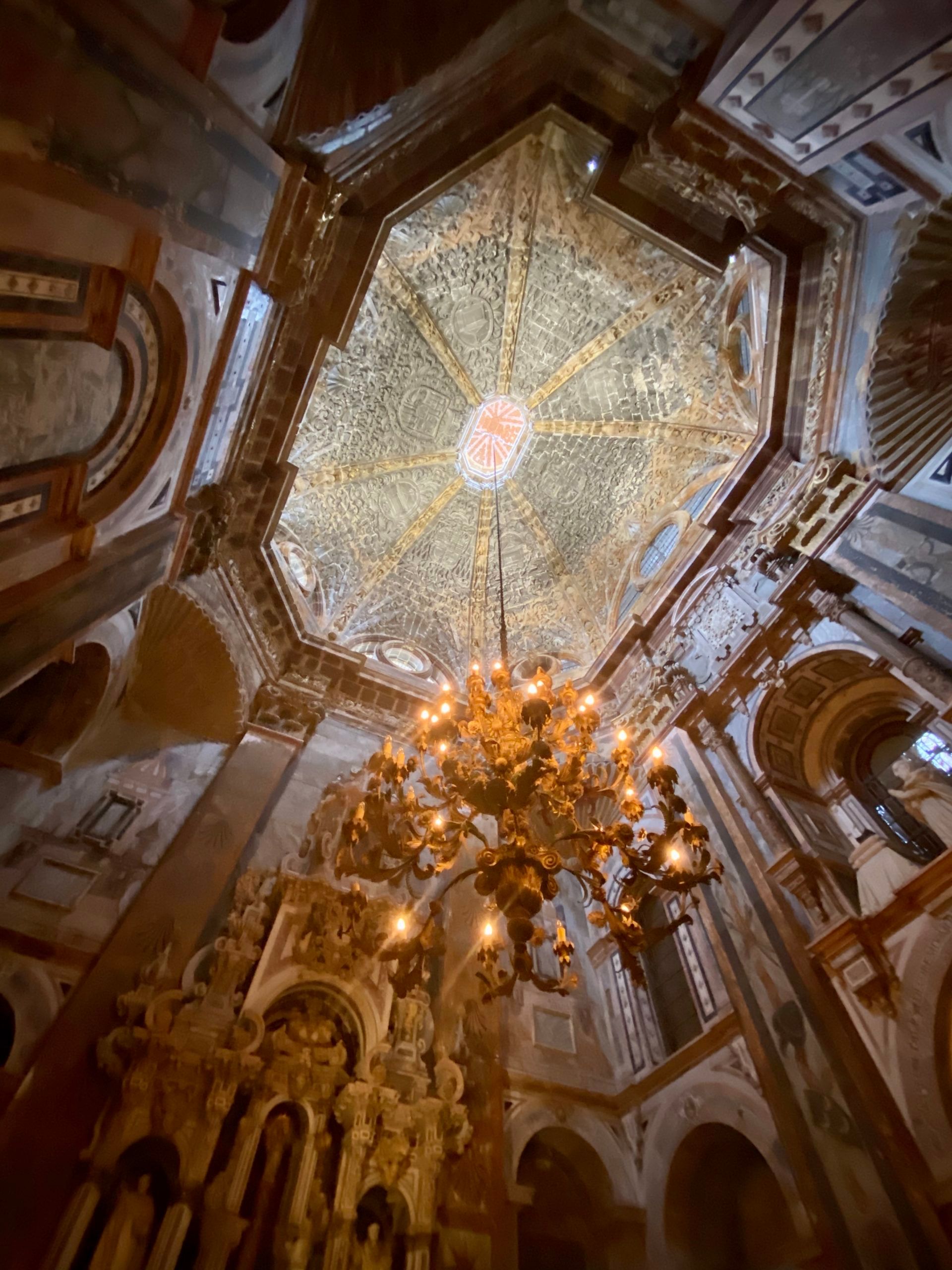
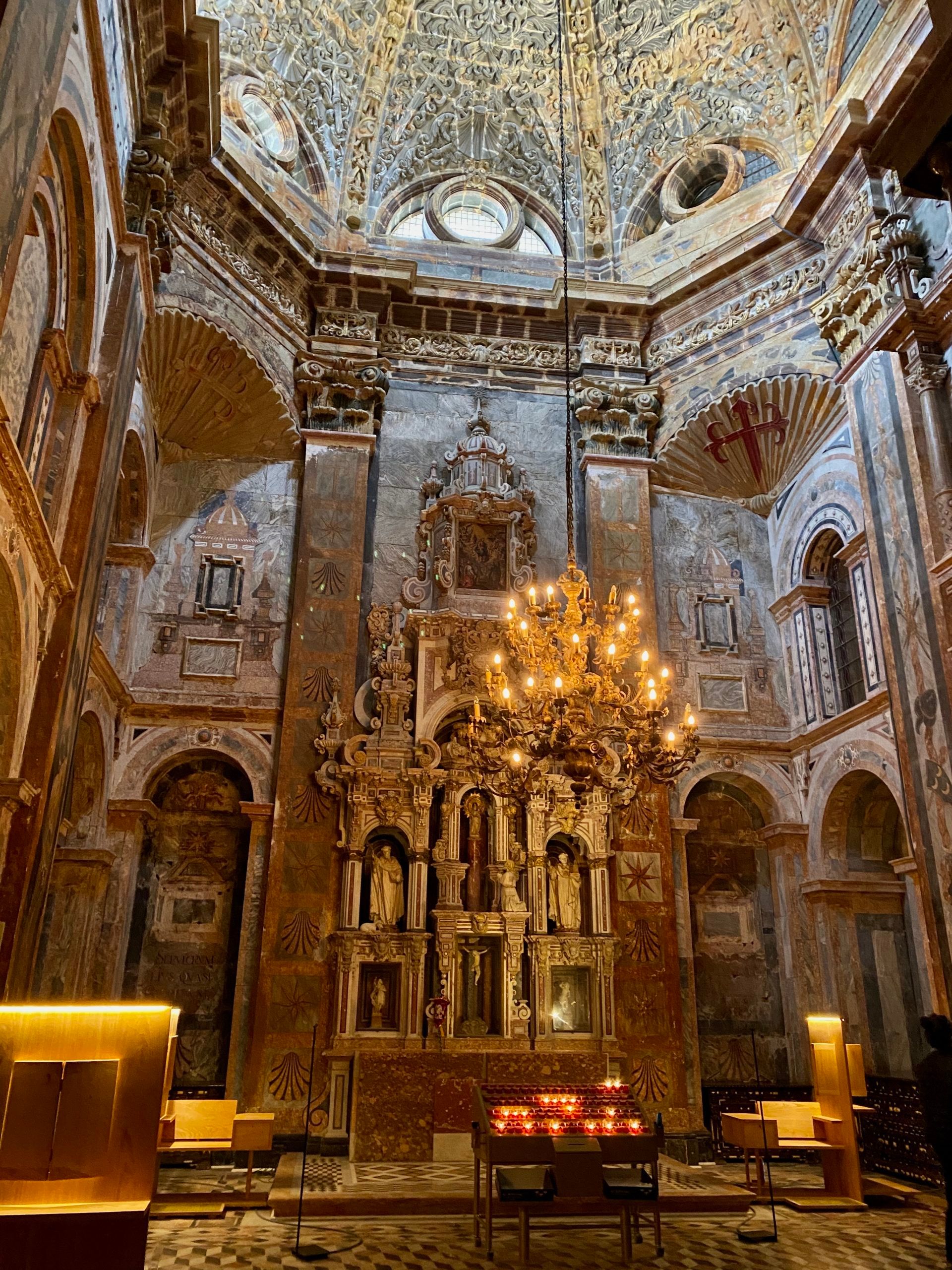
We started this morning in a farmhouse and we end it in the oldest operating hotel in the world, a medieval Parador built in 1499. Over centuries, pilgrims have been recovering here free of charge. When we collect our Compostela, a certificate of accomplishment given to pilgrims on completing a minimum of 62 miles (100 km), there is a mixture of emotions. In many ways, it feels like the other side of yesterday is better than this side of it. I want to continue on the path. I want to BE on the journey again.
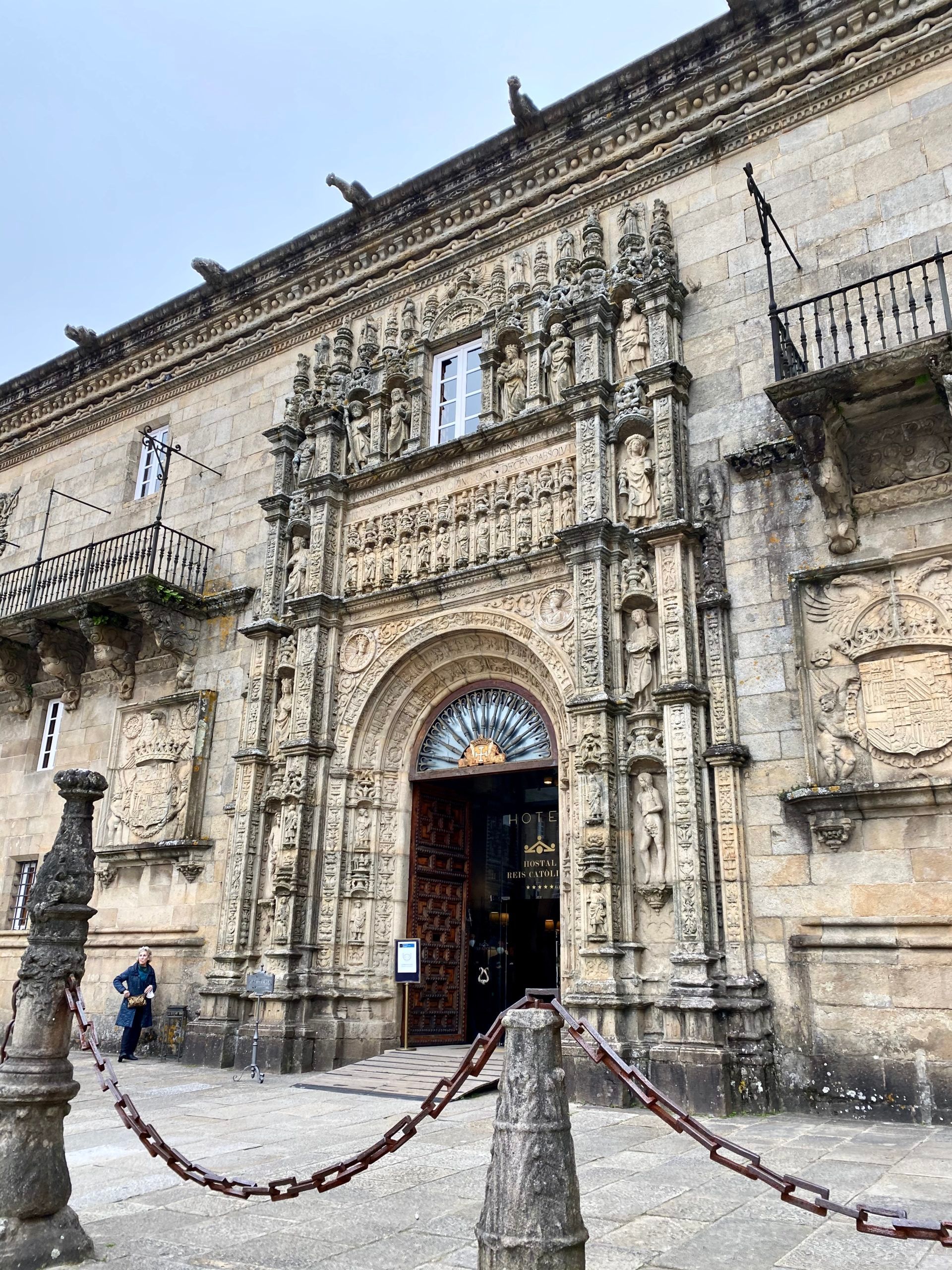
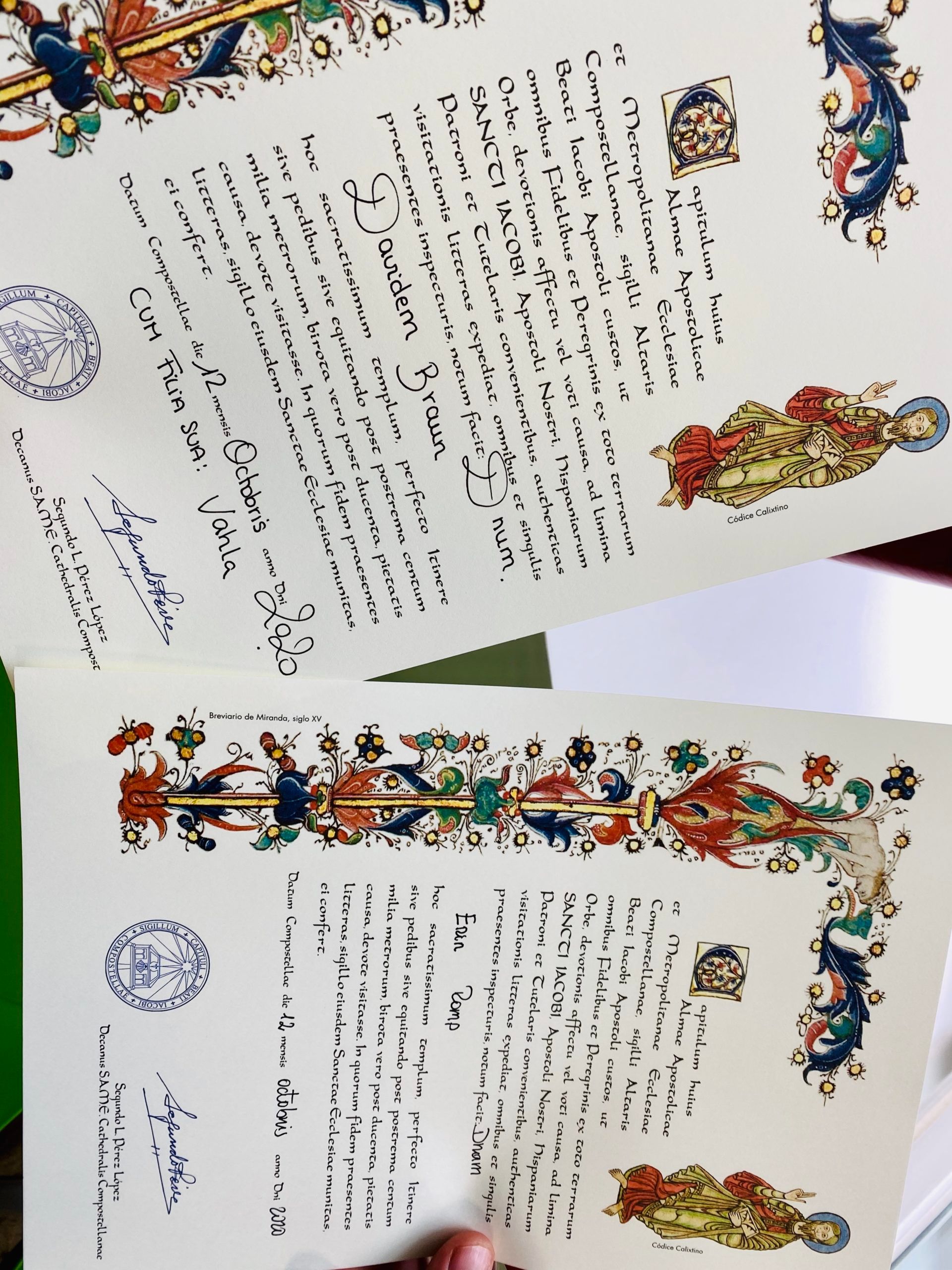
In deciding to walk the Camino, I wanted to do something to discover where my limits are, or where I think they might be. As I jog to catch up with the girls after a quick stop to film a particularly gorgeous section of ferns, I realize that I didn’t even come close, and I wonder what else is out there.
Our final official stop on the Camino is Finisterre on Spain’s western coast, a place that the Romans deemed “the end of the world” because they had no knowledge of the North American continent. Finisterre is also known as the Costa da Morte because of the multitude of shipwrecks caused by its jagged shores and the constant foggy weather near the cape. In fact, John Adams shipwrecked here in 1779 while on his way to Paris on a fundraising expedition. From there he walked the reverse direction of the pilgrim’s route to reach Paris overland without stopping at the cathedral. He even wrote in his memoir, “I have always regretted that we could not find time to make a Pilgrimage to Santiago de Compostela.”
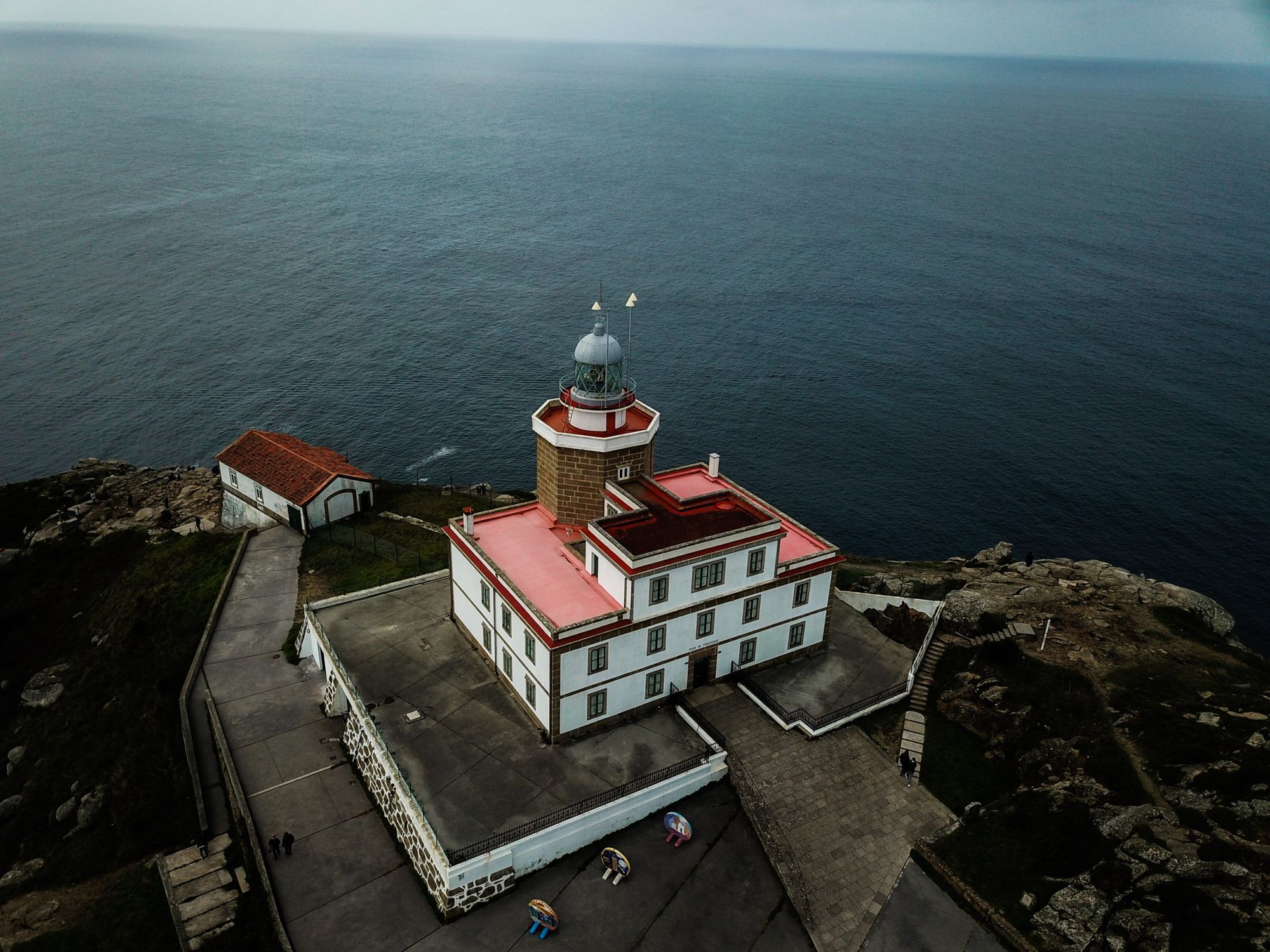
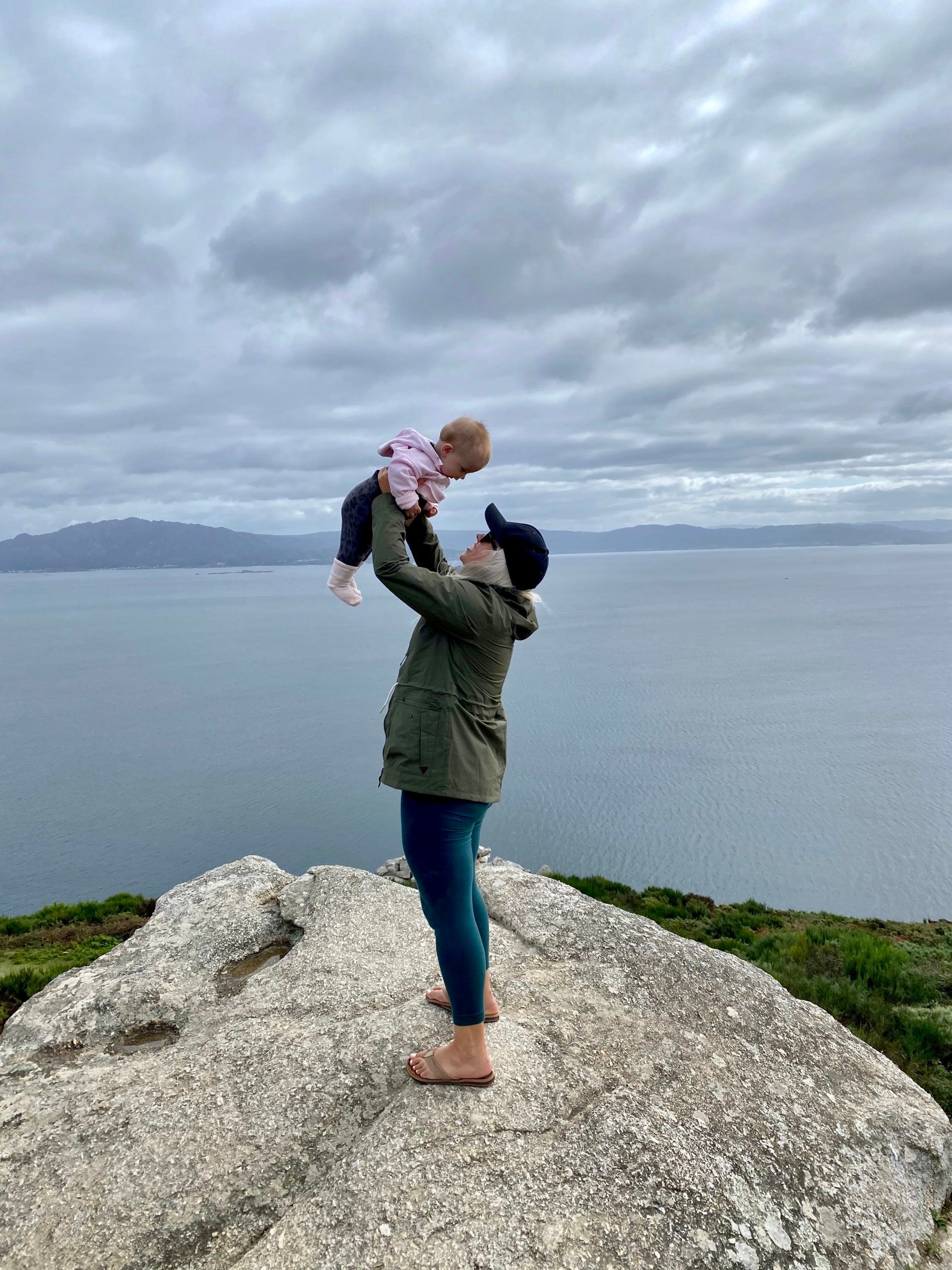
In 1853, the lighthouse was built 138 meters above sea level and powered with oil lamps. A siren tower was also installed to warn sailors against the dangers. It can be heard further than 20 miles. A former Navy beacon turned hotel sits in front of the towers that would be a perfect film set for a Wes Anderson movie.
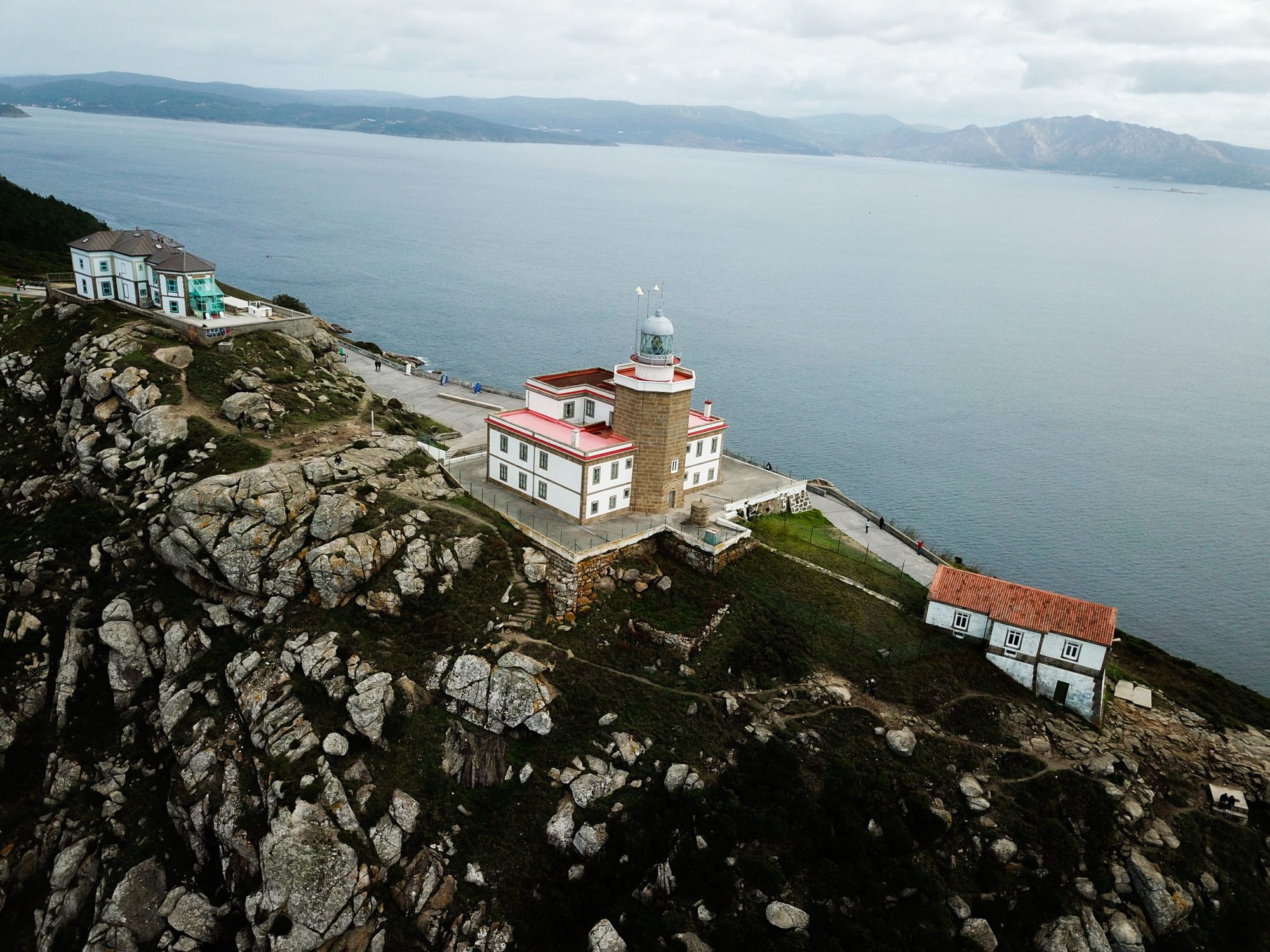
We explore the charming lighthouse and photograph the coastline’s rugged beauty. Neil Young’s Harvest Moon plays in the background. Erin and I smile at each other. This is the song that we play in our bedroom at the start of Vahla’s bedtime routine. It’s a sign that it’s time to go home, for now. I lived up to my wedding vow promise that I would follow Erin “to the ends of the Earth.” And I make the promise again.
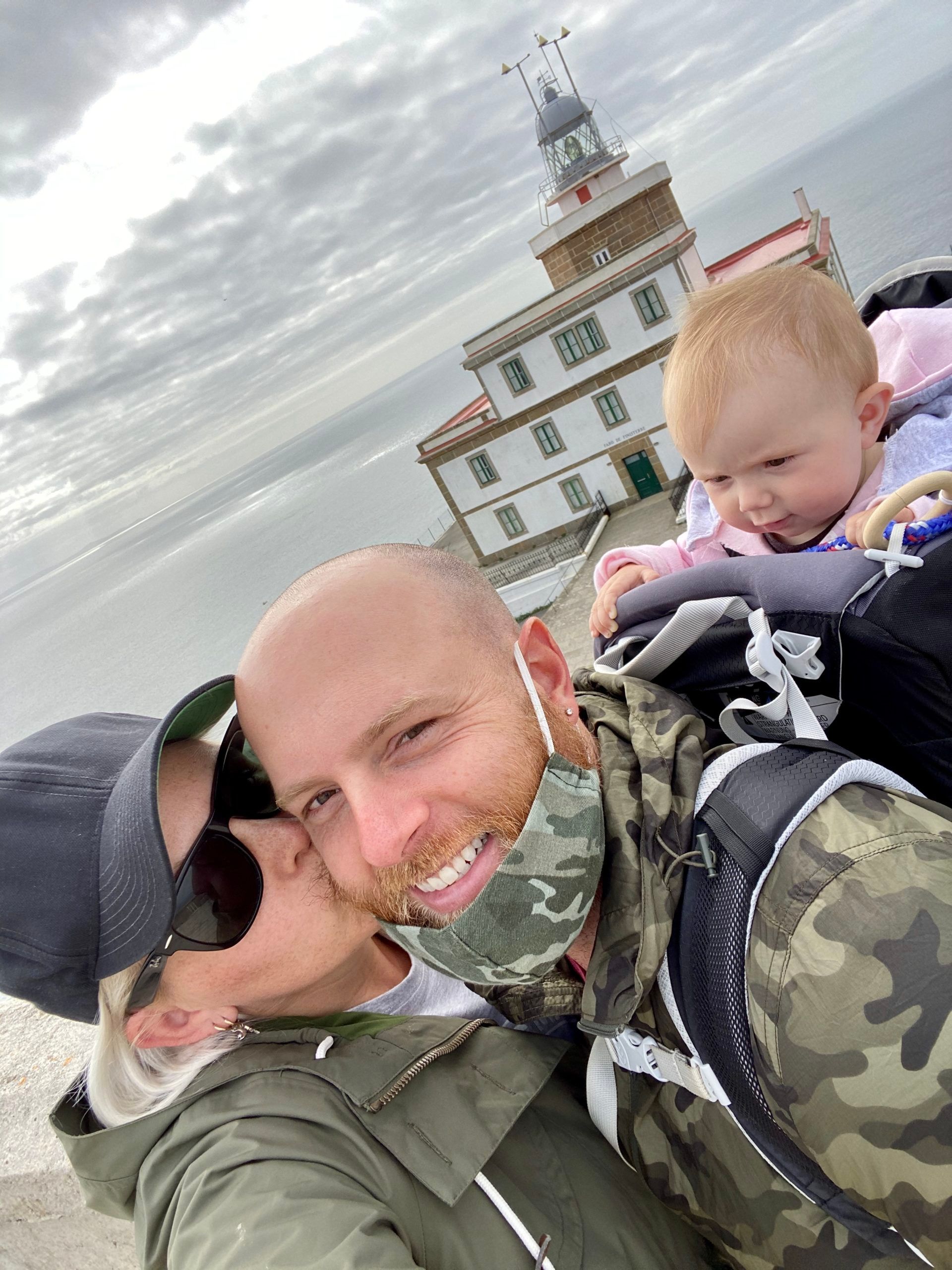
Davey Braun is the host of The Outdoor Journal Podcast, where he interviews the world's greatest athletes and explorers to find out what it takes to face fear and come out on the other side. For more adventure stories and travel videos by Davey Braun, check out the Far Out Expat Youtube channel. And stay tuned to The Outdoor Journal for tips on how to adventure travel with a Baby on Board.
2nd best newsletter in the universe